Motorola Solutions 89FT7606 ML900 Notebook PC w/ Wireless Radio Modem User Manual ML900 0
Motorola Solutions, Inc. ML900 Notebook PC w/ Wireless Radio Modem ML900 0
Contents
- 1. Users Manual Part 1
- 2. Users Manual Part 2
- 3. Users Manual Part 3
Users Manual Part 1
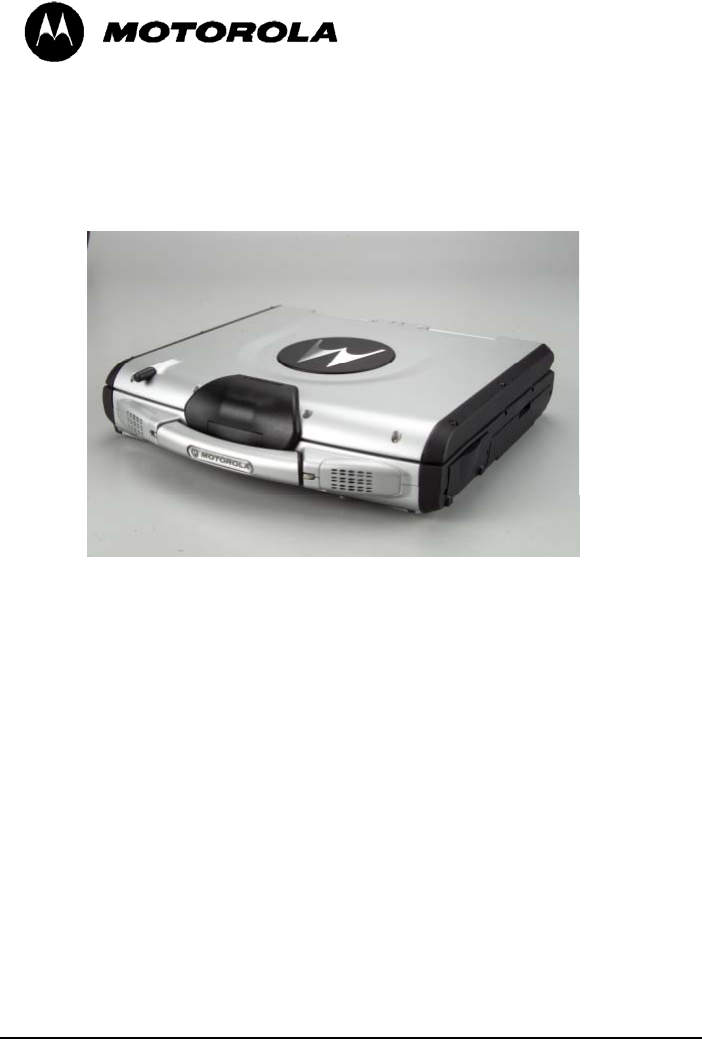
i
Mobile Laptop 900™
Model L3393, L3394
Motorola, Inc.
Commercial, Government and
Industrial Solutions Sector
All rights reserved
Owner’s Manual R02
Part No.: DDN 7415

TRADEMARKS
All brand and product names are trademarks or registered trademarks of their
respective companies.
NOTE
Information in this manual is subject to change without notice.

Regulations Information
Class B Regulations
USA
Federal Communications Commission Radio Frequency Interference Statement
NOTE:
This equipment has been tested and found to comply with the limits for a Class B digital
device pursuant to Part 15 of the FCC Rules. These limits are designed to provide
reasonable protection against harmful interference in a residential installation. This
equipment generates, uses, and can radiate radio frequency energy and, if not installed and
used in accordance with the instructions, may cause harmful interference to radio
communications. However, there is no guarantee that interference will not occur in a
particular installation. If this equipment does cause harmful interference to radio or
television reception, which can be determined by turning the equipment off and on, the user
is encouraged to try to correct the interference by one or more of the following measures:
−Reorient or relocate the receiving antenna.
−Increase the separation between the equipment and receiver.
−Connect the equipment into an outlet on a circuit different from that to which the
receiver is connected.
−Consult the dealer or an experienced radio/TV technician for help.
Any changes or modifications not expressly approved by the manufacturer could void the
user’s authority to operate the equipment.
Please note:
The use of a non-shielded interface cable with this equipment is prohibited.
Wireless LAN Module Statement
FCC CAUTION:
This device complies with Part 15 of the FCC Rules. Operation is subject to the following
two conditions: (1) this device may not cause harmful interference, and (2) this device must
accept any interference received, including interference that may cause undesired
operation.

FCC RF Radiation Exposure Statement
This equipment complies with FCC RF radiation exposure limits set forth for an
uncontrolled environment. This equipment should be installed and operated with a
minimum distance of 20 cm between the radiator and your body.
To assure continued compliance (example – use only shielded interface cables when
connecting to computer or peripheral devices), any changes or modifications not expressly
approved by the party responsible for compliance could void the user's authority to
operate this equipment.
Canada
Canadian Department of Communications
Radio Interference Regulations Class B Compliance Notice
This digital apparatus does not exceed the Class B limits for radio noise emissions from
digital apparatus set out in the Radio Interference Regulations of the Canadian Department
of Communications.
Le présent appareil numérique n’émet pas de bruits radioélectriques dépassant les limites
applicables aux appareils numériques de la classe B prescrites dans le Règlement sur le
brouillage radioélectrique édicté par le ministère des Communications du Canada.
SAFE USAGE NOTIFICATION:
For reason of personal safety and optimal radio performance, Motorola
has designed the ML900 with an intended purpose and position of use
either in a secured vehicle docking station or on the top of an office desk.
Motorola strongly recommends using this product in a vehicle only when
it is physically-secured in a lock or assured-stationary location as failure
to do so may cause the product to cause harm in accidents or other
conditions. Similarly, Motorola strongly recommends that the unit not be
situated for a prolonged period in an a position that places the antennas
directly against the human body ( for example, by “tucking” an
operational, radio-equipped unit under one’s arm). NOTE: The radio
modems in the ML900 may continue to transmit and receive signals even
while the laptop is in a closed position. Failure to follow any part of this
notification could cause degraded radio performance or harm to the
user”.

About the Battery
Caution Texts Concerning Lithium Batteries
DANISH
ADVARSEL!
Lithiumbatteri – Eksplosionsfare ved fejlagtig håndtering. Udskiftning må kun ske med
batteri af samme fabrikat og type. Levér det brugte batteri tilbage til leverandøren.
NORWEGIAN
ADVARSEL:
Eksplosjonsfare ved feilaktig skifte av batteri. Benytt samme batteritype eller en tilsvarende
type anbefalt av apparatfabrikanten. Brukte batterier kasseres i henhold til fabrikantens
instruksjoner.
SWEDISH
VARNING:
Explosionsfara vid felaktigt batteribyte. Använd samma batterityp eller en ekvivalent typ
som rekommenderas av apparattillverkaren. Kassera använt batteri enligt fabrikantens
instruktion.
FINNISH
VAROITUS:
Paristo voi räjähtää, jos se on virheellisesti asennettu. Vaihda paristo ainoastaan
valmistajan suosittelemaan tyyppiin. Hävitä käytetty paristo valmistajan ohjeiden
mukaisesti.
ENGLISH
CAUTION:
Danger of explosion if battery is incorrectly replaced. Replace only with the same or
equivalent type recommended by the equipment manufacturer. Discard used batteries
according to manufacturer's instructions.
DEUTSCH
VORSICHT:
Explosionsgefahr bei unsachgemäßem Austausch der Batterie. Ersatz nur durch denselben
oder einen vom Hersteller empfohlenen gleich-wertigen Typ. Entsorgung gebrauchter
Batterien nach Angaben des Herstellers.

FRENCH
ATTENTION:
II y a danger d’explosion s’il y a remplacement incorrect de la batterie. Remplacer
uniquement avec une batterie du même type ou d’un type équivalent recommandé par le
constructeur. Mettre au rebut les batteries usagées conformément aux instructions du
fabricant.
Attention (for USA Users)
The product that you have purchased contains a rechargeable battery. The battery is
recyclable. At the end of its useful life, under various state and local laws, it may be illegal to
dispose of this battery into the municipal waste stream. Check with your local solid waste
officials for details in your area for recycling options or proper disposal.
About the Modem
Caution
1. Never install telephone wiring during a lightning storm.
2. Never install telephone jacks in wet locations unless the jack is specifically designed for
wet locations.
3. Never touch uninsulated telephone wires or terminals unless the telephone line has been
disconnected at the network interface.
4. Use caution when installing or modifying telephone lines.
5. Avoid using the telephone function (other than a cordless-type) during an electrical
storm. There may be a remote risk of electric shock from lightning.
6. Do not use the telephone function to report a gas leak in the vicinity of the leak.
Caution (for USA Users)
To reduce the risk of fire, use only No.26 AWG or larger telecommunication line cord.

i
Table of Contents
Preface ....................................................................................... v
Chapter 1 Getting Started..................................................... 1-1
Getting the Computer Running..............................................1-2
Unpacking .......................................................................1-2
Connecting to AC Power .................................................1-3
Opening the Cover...........................................................1-4
Turning On and Off the Computer ..................................1-5
Taking a Look at the Computer.............................................1-6
Right-Side Components...................................................1-6
Left-Side Components.....................................................1-7
Rear Components ............................................................1-8
Front Components.........................................................1-10
Bottom-Side Components..............................................1-11
Top-open Components..................................................1-13
Where to Go from Here.......................................................1-16
Chapter 2 Operating Your Computer................................... 2-1
Starting and Stopping the Computer......................................2-2
Starting the Computer......................................................2-2
Stopping the Computer....................................................2-2
Using the Keyboard...............................................................2-4
Typewriter Keys ..............................................................2-4
Cursor-Control Keys........................................................2-5

ii
Numeric Keypad..............................................................2-5
Euro Symbol....................................................................2-6
Windows Keys.................................................................2-6
Function Keys..................................................................2-6
Fn Key.............................................................................2-7
Hot Keys..........................................................................2-7
Using the Touchpad ..............................................................2-9
Configuring the Touchpad.............................................2-11
Using the Touchscreen (option) ..........................................2-12
Using the Hard Disk Drive...................................................2-13
Using the CD/DVD/Combo Drive........................................2-14
Installing the CD/DVD/Combo Drive.............................2-15
Inserting and Removing a CD........................................2-16
Using the Video Features.....................................................2-17
Configuring the Display Modes......................................2-17
Using the Audio Features ....................................................2-19
Connecting Audio Devices.............................................2-20
Using the Communication Features.....................................2-21
Using the LAN...............................................................2-21
Using the Wireless LAN.................................................2-22
Using the Wireless Modem.............................................2-23
Using the GPS................................................................2-24
Chapter 3 Managing Power .................................................. 3-1
AC Adapter...........................................................................3-2
Battery Pack ..........................................................................3-3
Charging the Battery Pack................................................3-3
Initializing the Battery Pack..............................................3-4
Checking the Battery Level ..............................................3-4
Replacing the Battery Pack...............................................3-5
Battery Low Signals and Actions......................................3-6
Power Management...............................................................3-7
Hibernation......................................................................3-8
Power-Saving Tips................................................................3-9

iii
Chapter 4 Expanding Your Computer ................................. 4-1
Connecting an External Monitor............................................4-2
Connecting a USB Device .....................................................4-3
Connecting a Serial Device....................................................4-4
Connecting an IR Device.......................................................4-5
Connecting a Bluetooth-compliant Device (option)...............4-7
Connecting an IEEE 1394 Device ..........................................4-9
Connecting a Video Capture Device....................................4-10
System Memory Upgrade....................................................4-10
Chapter 5 Setup Configuration Utility (SCU)....................... 5-1
When and How to Use the SCU Program ..............................5-2
When to Use ....................................................................5-2
Starting SCU....................................................................5-2
Moving Around and Making Selections...........................5-4
Startup Menu ........................................................................5-5
Disks Menu...........................................................................5-8
Components Menu................................................................5-9
Power Menu........................................................................5-13
Exit Menu............................................................................5-14
Chapter 6 Installing Software Drivers................................. 6-1
How to Use the Driver CD.....................................................6-2
Installing Drivers for Windows 2000.....................................6-3
Touchscreen Driver .........................................................6-6
Installing Drivers for Windows XP .......................................6-7
Touchscreen Driver .......................................................6-10
Touchscreen Utility........................................................6-16
Chapter 7 Caring for the Computer ..................................... 7-1
Protecting the Computer........................................................7-2
Using the Password..........................................................7-2
Using an Anti-Virus Strategy............................................7-2
Taking Care of the Computer................................................7-3

iv
Location Guidelines.........................................................7-3
General Guidelines...........................................................7-3
Cleaning Guidelines.........................................................7-4
Battery Pack Guidelines ...................................................7-4
When Traveling ....................................................................7-5
Chapter 8 Troubleshooting .................................................. 8-1
Preliminary Checklist............................................................8-2
Solving Common Problems ..................................................8-3
Battery Problems..............................................................8-4
CD/DVD/Combo Drive Problems....................................8-4
Display Problems.............................................................8-5
Fingerprint Recognition Problems ...................................8-7
Hardware Device Problems..............................................8-7
Hard Disk Drive Problems...............................................8-7
Infrared Problems............................................................8-8
Keyboard, Mouse, and Touchpad Problems.....................8-8
LAN Problems.................................................................8-9
WLAN Problems .............................................................8-9
Modem Problems.............................................................8-9
Power Management Problems (for Windows)................8-11
Printer Problems............................................................8-12
Software Problems ........................................................8-12
Sound Problems ............................................................8-13
Startup Problems ...........................................................8-14
Other Problems..............................................................8-15
Resetting the Computer .......................................................8-16
Appendix A Specifications.................................................... A-1
Appendix B Fingerprint Recognition System ......................B-1
Finger Placement..................................................................B-2
Using the Fingerprint Recognition System Utility .................B-3

v
Preface
This manual contains information that will help you operate the
computer. It is divided into 8 chapters and an appendix.
l Chapter 1, Getting Started, takes you through the process of setting
up the computer and identifying its external components.
l Chapter 2, Operating Your Computer, tells you how to use the
computer’s components and features.
l Chapter 3, Managing Power, provides information on power.
l Chapter 4, Expanding Your Computer, provides information on
installing and using peripheral devices.
l Chapter 5, SCU (Setup Configuration Utility), describes the SCU
program that configures the computer’s BIOS settings.
l Chapter 6, Installing Software Drivers, describes how to install the
drivers and utilities supplied with the computer.
l Chapter 7, Caring for the Computer, gives you tips in care and
maintenance.
l Chapter 8, Troubleshooting, gives solutions to common problems
you may encounter when using the computer.
l Appendix A, Specifications, gives a brief specification of the
computer.

vi
l Appendix B, Fingerprint Recognition System, provides
information on using the system’s fingerprint recognition system.
Notational Conventions
Throughout this manual, the following conventions are used to
distinguish elements of text.
NOTE: identifies additional information that requires special attention.
CAUTION: identifies important information which, if not followed, may result in loss
of data or damage to the computer.
Keyboard keys are shown in a bold typeset. For example:
Press Enter to complete.
When keys are joined by a plus sign (+), press the first key, and, while
keeping the first key down, press the remaining keys, finally release all the
keys. When necessary, keys are also shown in graphics.
A title, command, setup item, or button that you can see on the screen is
shown in boldface. A value or an option that you can select for a setup
item is shown in italic. For example:
Select Power Management, set it to Enabled, and then click the
OK button.

CHAPTER 1
Getting Started
Congratulations on purchasing this computer.
This high performance notebook computer is especially designed for the
practical applications of warehouses, automobiles, vehicles, public
security, repairing, assisting the handicapped, and other demanding
situations where conventional notebook computers just cannot measure
up.
This chapter first tells you step by step how to get the computer up and
running. You will find instructions for these procedures:
l Unpacking
l Connecting to AC power
l Opening the cover
l Turning on the computer
l Turning off the computer
Then, you will find a section briefly introducing the external components
of the computer. And the last section navigates you to the information
you may need after the computer is ready for use.

1-2 Getting Started
Getting the Computer Running
This section guides you through the procedures for getting the computer
ready for operation.
Unpacking
After unpacking the shipping carton, you should find these standard
items:
l Notebook computer
l Accessories:
− AC adapter (100~240 VAC, 50/60 Hz)
− AC power cord (US/CE/UK/SA)
− Driver CD
− This Operation Manual
Inspect all the items. If any item is damaged or missing, notify your
dealer immediately.
Keep the shipping carton and packing materials in case you need to ship
or store the computer in the future.
Connecting to AC Power
The computer operates either on the external AC power or internal
battery power. It is suggested that you use AC power when you start up
the computer for the first time.
CAUTION: Use only the AC adapter included with your computer. Using other AC
adapters may damage the computer.
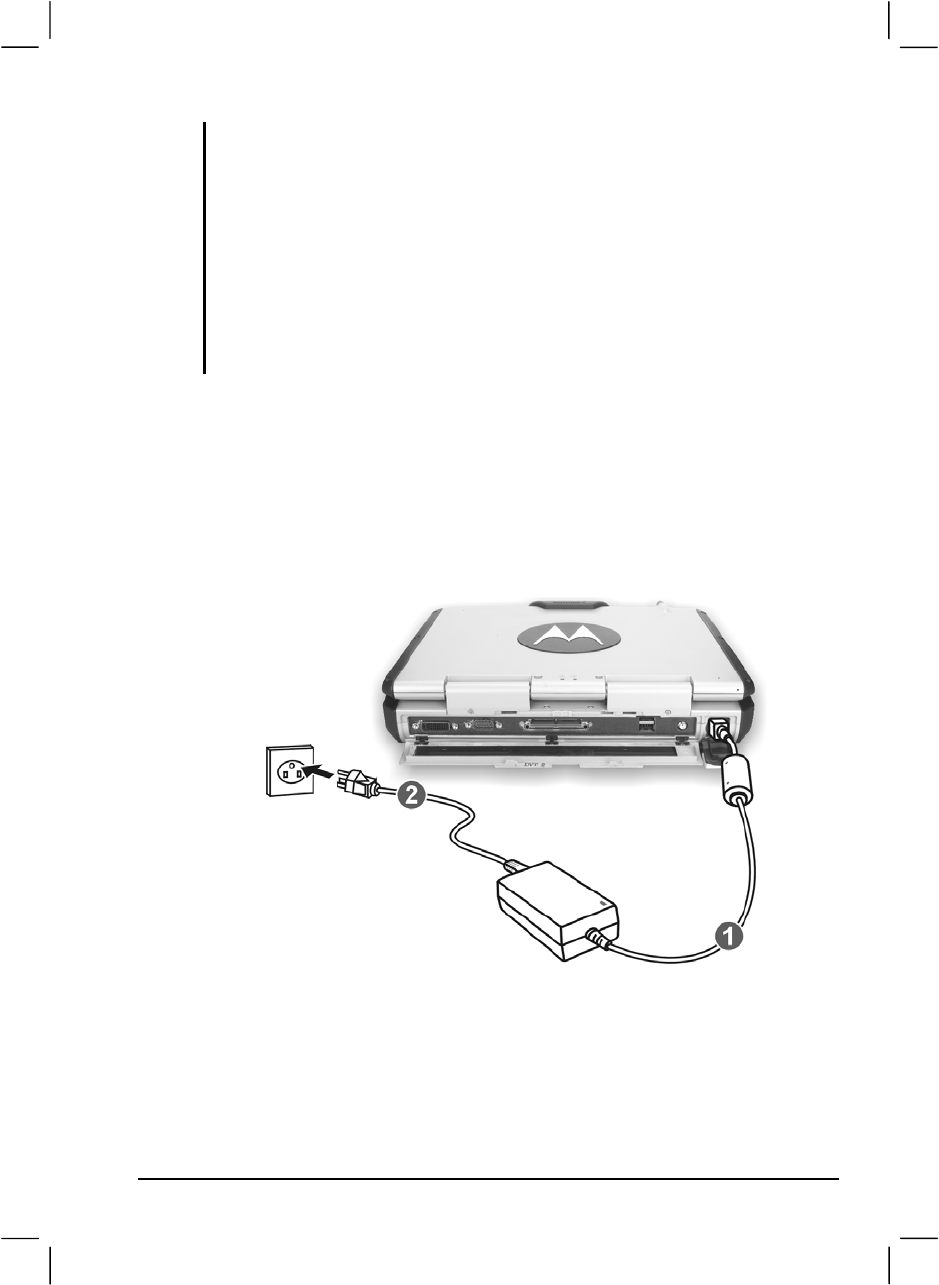
Getting Started 1-3
NOTE:
Power Supply Cord: (optional) Detachable, minimum 1.5 m long. Listed, rated
minimum 125 V, 7 A, having a 2/18 AWG, type SVT flexible cord. One end terminates
with a parallel blade, molded-on, attachments plug with a 7 A, 125 V (NEMA 1-15P)
configuration; other end terminates with a molded-on appliance coupler.
Alternative: (optional) Detachable, maximum 4.5 m (14.76 ft) long. Listed, rated
minimum 250 V, 6 A, having a 3/18 AWG, type SVT flexible cord. One end terminates
with a Tandem blade, grounding, listed molded-on, attachments plug with a 6 A, 250 V
(NEMA 6-15P) configuration; other end terminates with a molded-on appliance
coupler.
1. Make sure the computer is turned off.
2. Plug the DC cord of the AC adapter to the power connector on the
rear side of the computer (n) .
3. Plug the female end of the AC power cord to the AC adapter and the
male end to an electrical outlet (o) .
4. When the AC adapter is connected, the indicator on the AC adapter
lights up, indicating that power is being supplied from the electrical
outlet to the AC adapter and onto your computer. Now, you are ready
to turn on the computer.
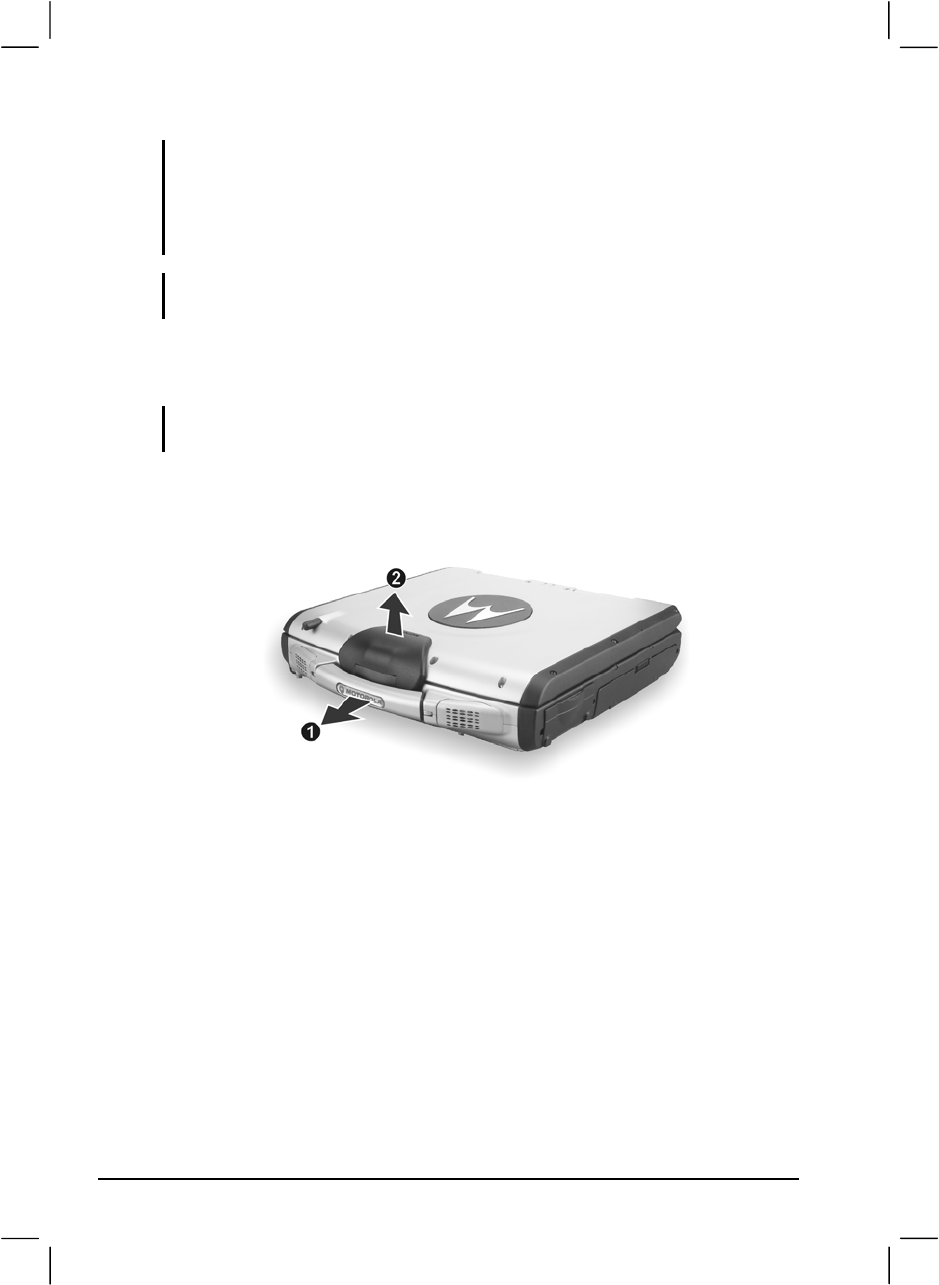
1-4 Getting Started
CAUTION:
z When you disconnect the AC adapter, disconnect from the electrical outlet first and
then from the computer. A reverse procedure may damage the AC adapter or the
computer.
z When unplugging the connector, always hold the plug head. Never pull on the cord.
NOTE: When the AC adapter is connected, it also charges the battery pack. For
information on using battery power, see Chapter 3.
Opening the Cover
CAUTION: Be gentle when opening and closing the cover. Opening it vigorously or
slamming it shut could damage the computer.
1. Open the top cover by pulling on the handle, inserting your index
finger, and then pulling on the cover latch.
2. Lift up the cover. You can tilt the cover forward or backward for
optimal viewing clarity.
Turning On and Off the Computer
Turning On
1. Make sure the computer is connected to AC power.
2. Press the power button.
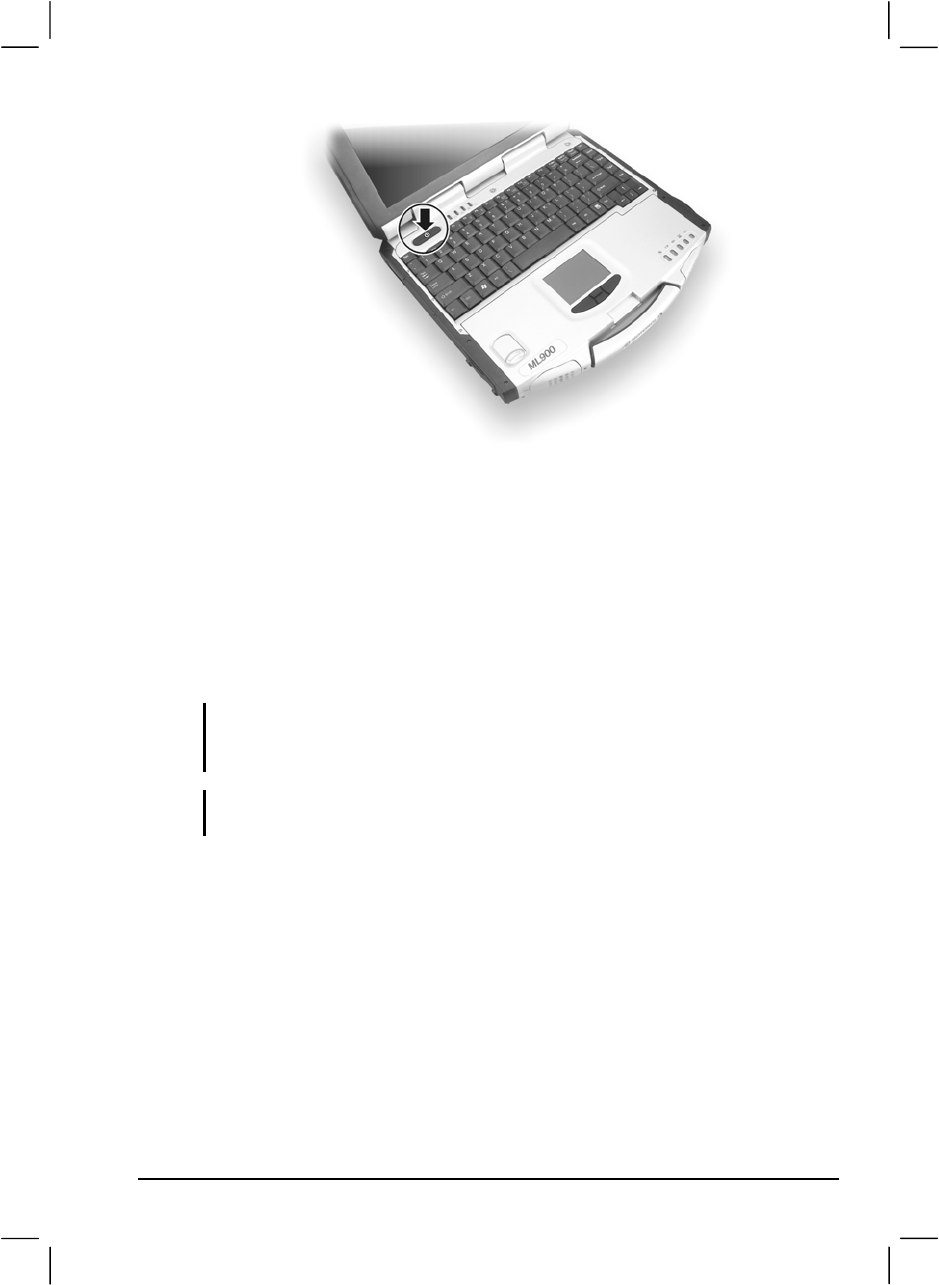
Getting Started 1-5
3. Each time the computer is turned on, it performs a Power-On Self
Test (POST), and the operating system such as Windows should
start.
Turning Off
To turn off the computer power, use the “Shut Down” command of your
operating system.
NOTE: There are other ways you can stop the computer so that you will be back to
where you left off when you next turn on the computer. (See “Stopping the Computer”
in Chapter 2 for information.)
CAUTION: If you have to turn the computer on again immediately after turning it off,
wait for at least five seconds. Turning the computer off and on rapidly can damage it.
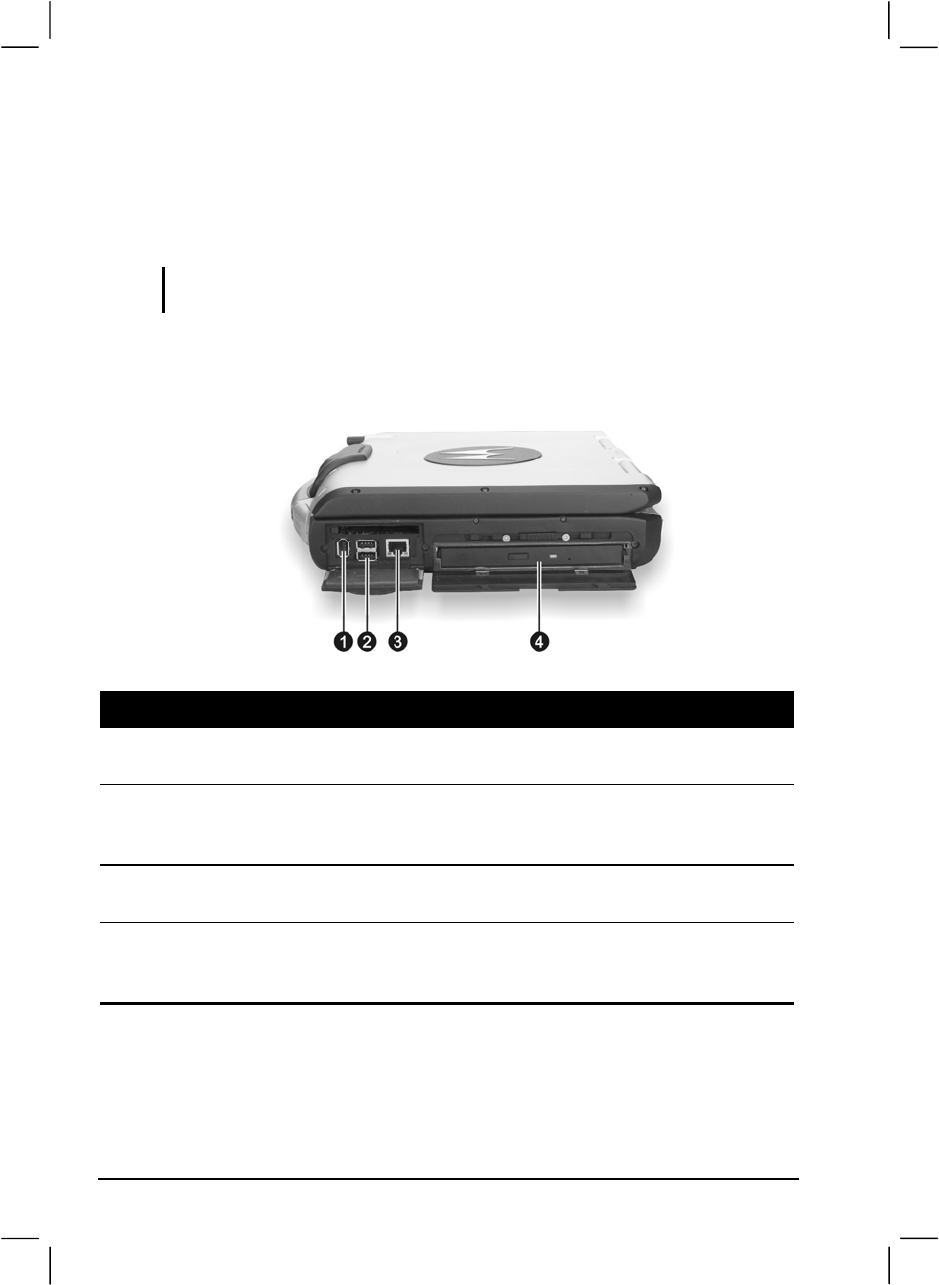
1-6 Getting Started
Taking a Look at the Computer
This section identifies the external components of the computer and
briefly describes the function of each component.
NOTE: Depending on the model you purchased, the appearance of your computer may
not exactly be the same as those shown in this manual.
Right-Side Components
Ref Component Description See Also
nIEEE 1394 Port Connects a 1394 device, such as a scanner,
printer, digital camera, joystick, and more.
P. 4-7
oUSB Ports Each of the two ports connects a USB device,
such as a USB floppy drive, printer, digital
camera, joystick, and more.
P. 4-3
pRJ-45
Connector
Connects the LAN cable. Includes a Link
Indicator and an Active Indicator.
P. 2-21
qCD/DVD/
Combo Drive
Accepts a compact disc (CD) for installing or
loading software, accessing data, and playing
music/video.
P. 2-14
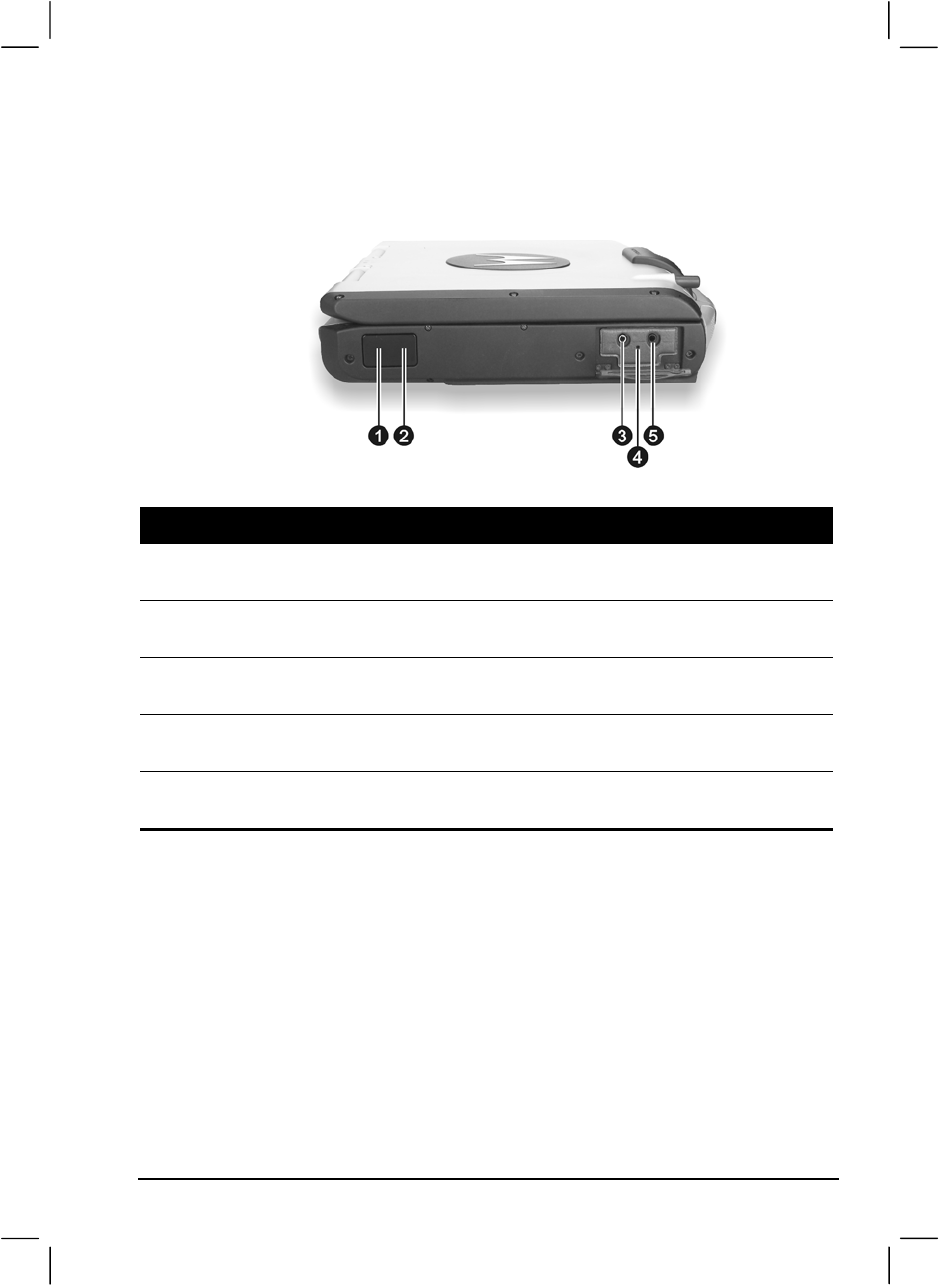
Getting Started 1-7
Left-Side Components
Ref Component Description See Also
nIR Port Connects an IrDA-compliant device for wireless
data transfer.
P. 4-5
oBluetooth Port
(option)
Connects a bluetooth-capable device for
wireless data transfer.
P. 4-5
pMicrophone
Connector
Connects an external microphone. P. 2-20
qKeyboard BIOS
Reset Switch
Use this to turn off the system when resetting the
system using Ctrl+Alt+Del does not work.
P. 8-17
rAudio Output
Connector
Connects a set of headphones, external speakers
with amplifier, or an audio recording device.
P. 2-20
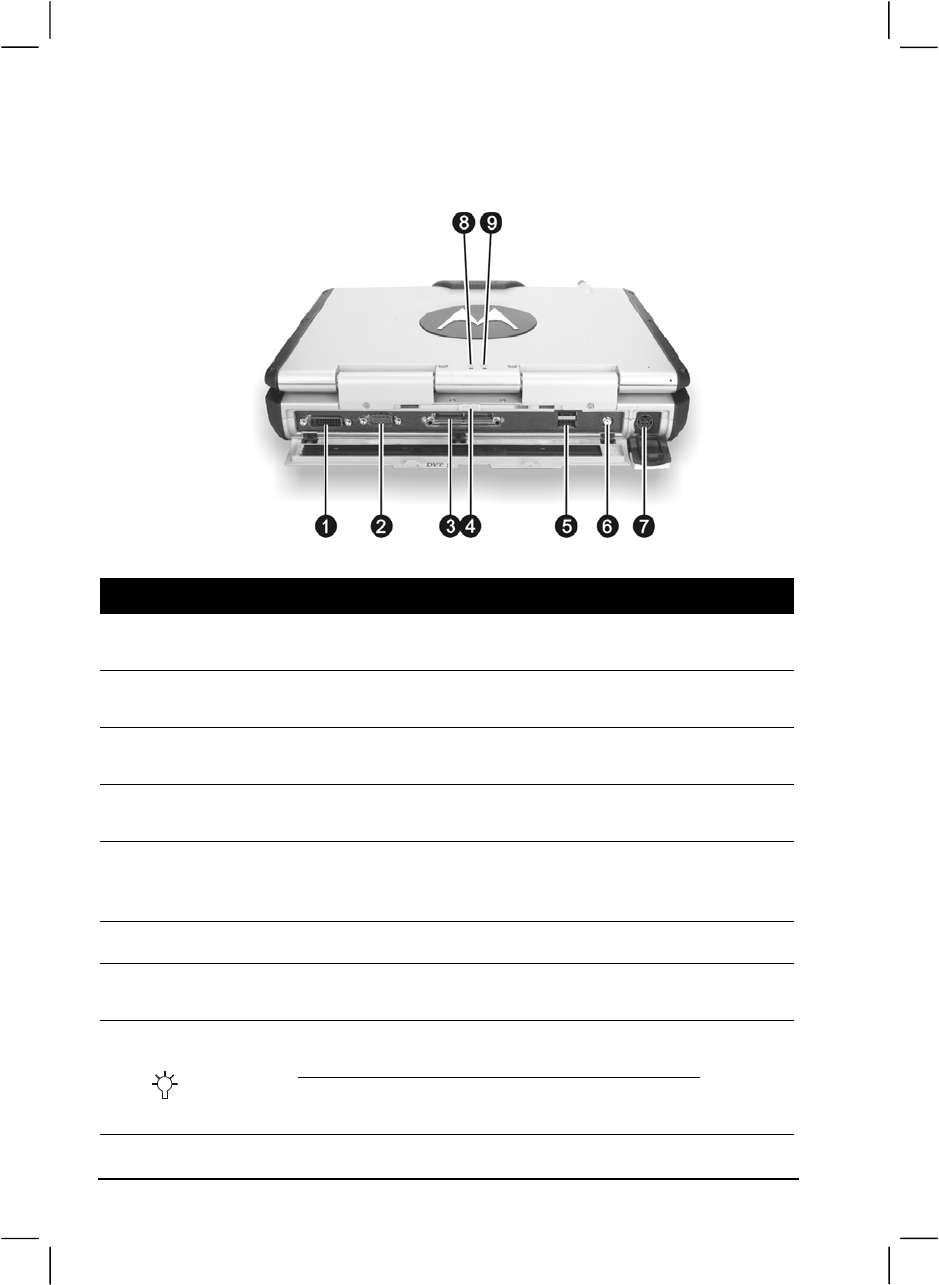
1-8 Getting Started
Rear Components
Ref Component Description See Also
nDVI-I Port Connects an external monitor with a DVI
interface.
P. 4-2
oSerial Port Connects a serial device, such as an external
modem.
P. 4-4
pDocking Port For connecting to a Port Replicator / car mount
(both are available as an option).
qRear Cover
Latch
Locks the rear cover.
rUSB Ports Each of the two ports connects a USB device,
such as a floppy disk drive, printer, digital
camera, joystick, and more.
P. 4-3
sAV Input Port Connects to a video recording device. P. 4-8
tPower
Connector
Connects the AC adapter. P. 1-3
Glows (green) when the computer, using AC
power.
uAC Power
Indicator
Glows (orange) when the computer, using AC
power, is in Standby mode.
P. 1-4

Getting Started 1-9
Ref Component Description See Also
Glows green when the battery is fully charged
and connected to AC power.
”Battery Charge
Indicator
Glows amber (orange) when the battery is being
charged.
P. 3-3
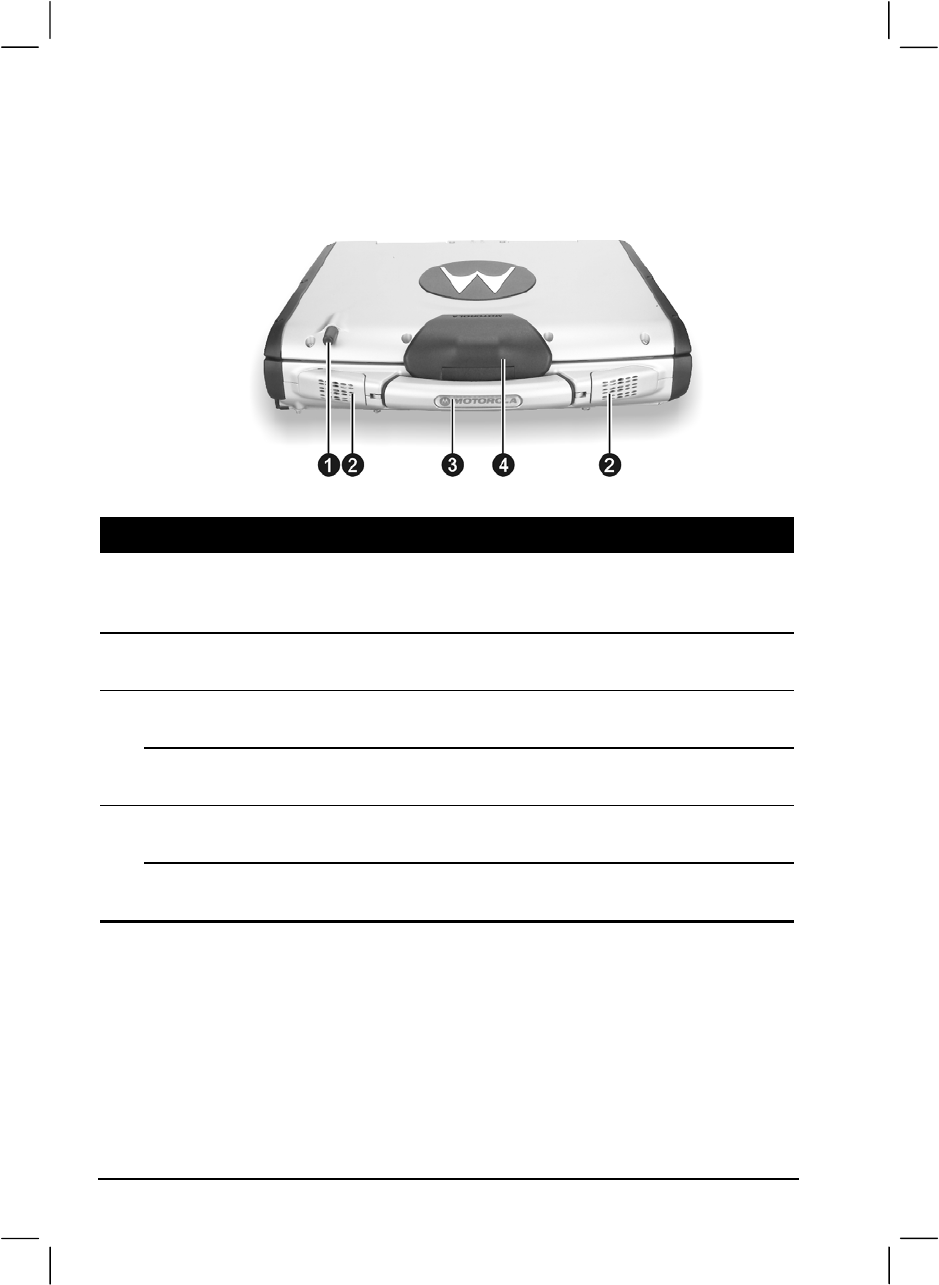
1-10 Getting Started
Front Components
Ref Component Description See Also
nWireless
Modem
Antenna
Serves as the antenna for the optional wireless
modem (RDLAP, GPRS and CDMA).
P. 2-23
oStereo Speaker
Set
Sends out sound and voice from the computer. P. 2-20
Handle Allows you to carry your computer for an easy
grip.
p
Wireless LAN
Antenna
Serves as the antenna for the WLAN. It is built-
in the handle.
P. 2-22
GPS Antenna
(option)
Serves as the antenna for the Global Positioning
System (GPS). It is built-in the top cover latch.
P. 2-24
q
Top Cover
Latch
Locks the top cover. P. 1-4
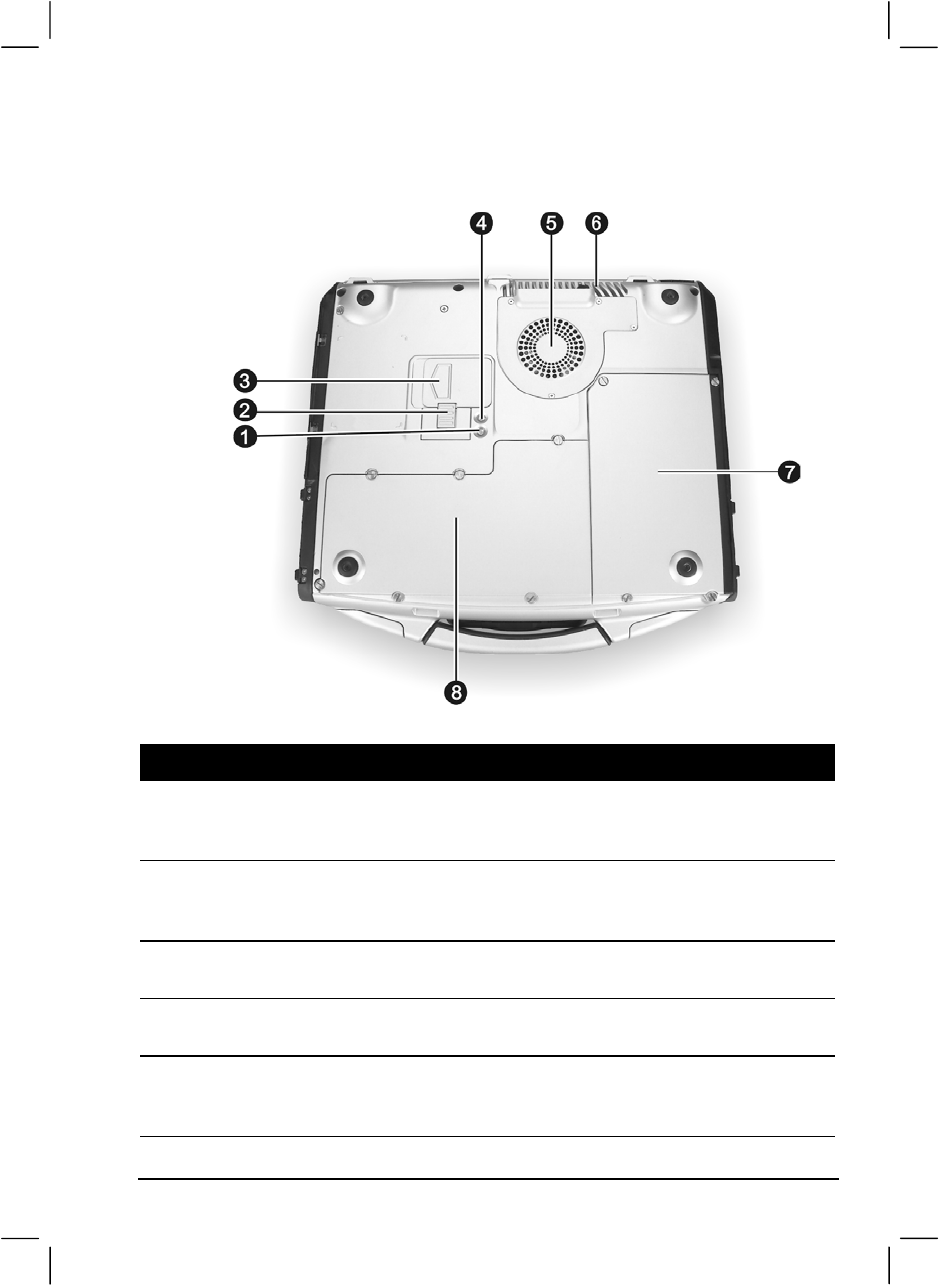
Getting Started 1-11
Bottom-Side Components
Ref Component Description See Also
nX-bay Module
Antenna
Connector
Serves as the interface between the system and
external antenna of the optional X-bay module.
oCD/DVD Drive
Lock/Unlock
Switch
Allows you to lock the CD/DVD drive in place. P. 2-15
pCD/DVD Drive
Eject Latch
Allows you to remove the CD/DVD drive (can
also contain the Combo drive).
P. 2-15
qGPS Antenna
Connector
Serves as the interface between the system and
external GPS antenna.
P. 2-24
rCPU Socket and
Sealed CPU
Cooling Fan
Inside is the CPU of your computer and cooling
fan to protect it from overheating.

1-12 Getting Started
Ref Component Description See Also
‘Ventilation
Openings
Do not cover or block the ventilation openings
for air circulation thus preventing overheating.
’Battery Pack Supplies power to your computer when external
power is not connected. P. 3-3
X-Bay Interface
(top right)
Connects additional wireless modem (GPRS/
GSM).
Mini PCI Slot
(bottom right)
Inside is the Mini PCI slot for using an optional
Mini PCI card.
Hard Disk
Drive
Compartment
(top left)
Contains the hard disk drive of your computer. P. 2-13
“
Memory Slot
(bottom left)
Contains the memory slot for expanding the
memory size of your computer. P. 4-9
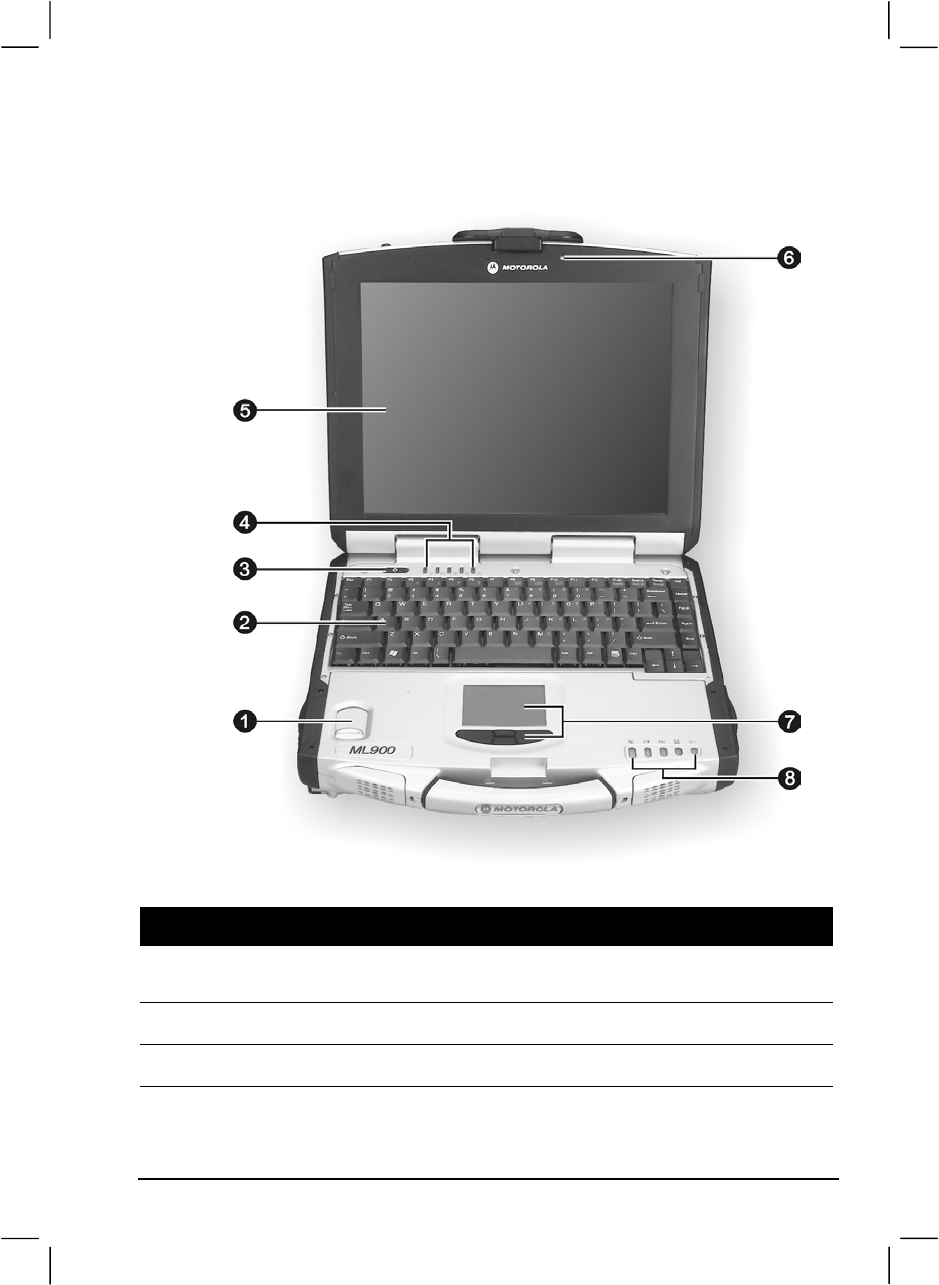
Getting Started 1-13
Top-open Components
Ref Component Description See Also
nFingerprint
Scanner
Contains the fingerprint sensor. P. B-1
oKeyboard Serves as the data input device of the computer. P. 2-4
pPower Button Turns the computer power ON and OFF. P. 1-5
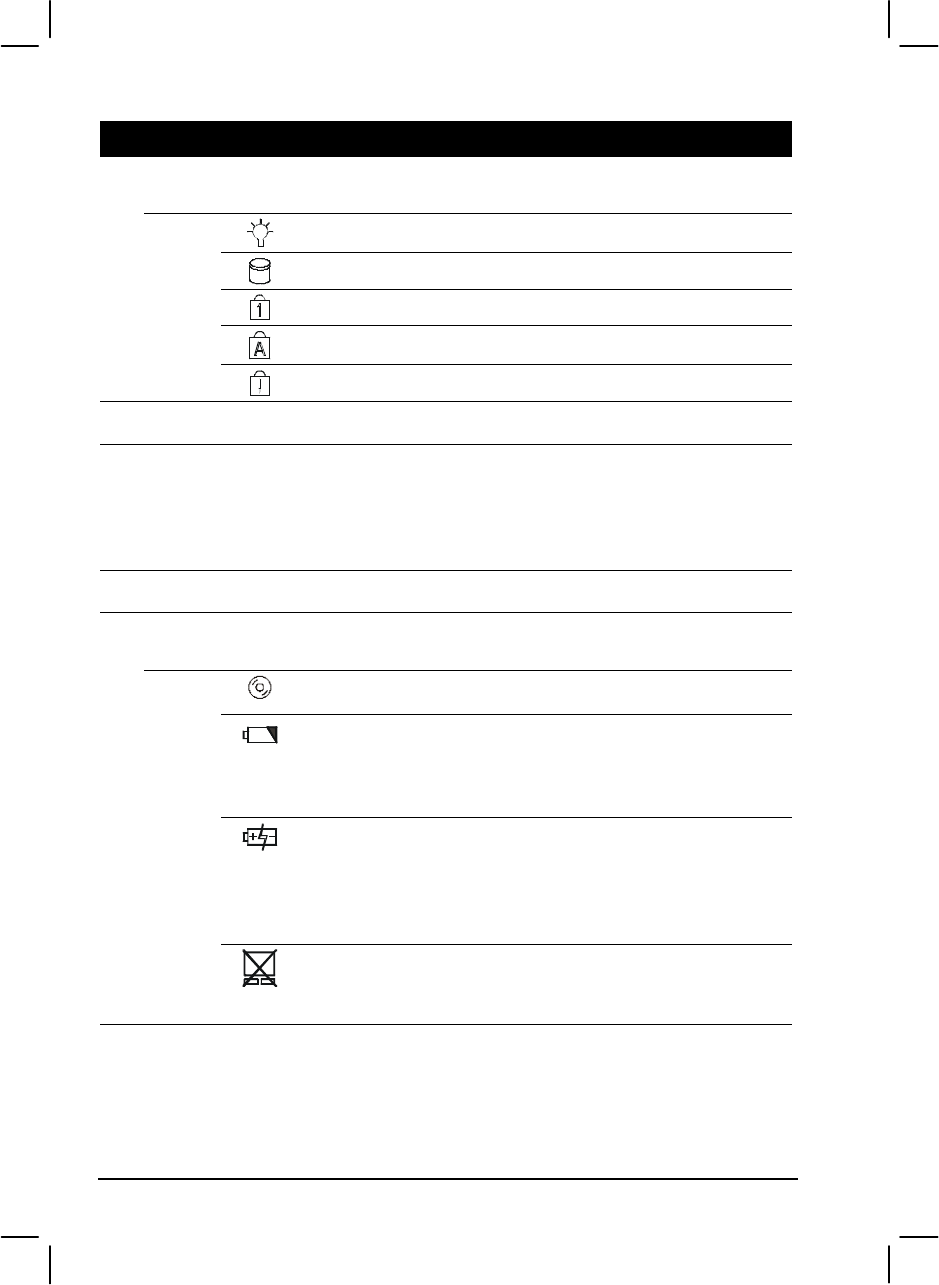
1-14 Getting Started
Ref Component Description See Also
Device
Indicators
Show the current status of the computer’s
devices.
Power on / Standby mode indicator P. 1-3
Hard disk drive in-use indicator P. 2-13
Num Lock indicator P. 2-6
Caps Lock indicator P. 2-4
•
Scroll Lock indicator P. 2-4
•LCD Screen Displays the output of the computer. P. 2-17
‘Light Sensor Automatic light sensor for dimming the
display’s backlight. Will function only if your
system comes with the optional sunlight
readable transflective LCD display and/or
keyboard with optional backlight function.
P. 2-17
’Touchpad Serves as the pointing device of the computer. P. 2-9
“Device
Indicators
Show the current status of the computer’s
devices.
CD/DVD drive in-use indicator P. 2-14
Battery Low indicator –
Blinks red when the battery is almost
completely discharged.
P. 3-3
Battery charge indicator –
Glows green when the battery is fully charged
and connected to AC power.
Glows amber (orange) when the battery is being
charged.
P. 3-3
Touchpad indicator –
Glows red when the touchpad is disabled. Can
be enabled/disabled using the hot keys Fn+F7.
P. 2-9

Getting Started 1-15
Ref Component Description See Also
AC in and HDD heater on indicator –
Glows green when the computer is connected to
AC power.
Blinks red when the hard disk heater is on.
P. 1-4
P. 2-13

1-16 Getting Started
Where to Go from Here
As your computer is ready for operation, you may want to do any of the
following now:
For this purpose …Do this …
To know more about the computer …Go on to the next chapter.
To install the operating system if your
dealer has not already done so …See the operating system manual.
To know more about the operating
system …Read the operating system manual.
To install the drivers if your dealer has
not already done so …See Chapter 6.
To set a power-on password …See “Startup Menu” in Chapter 5.
To charge the battery pack for the first
time …See “Charging the Battery Pack” in
Chapter 3.

CHAPTER 2
Operating Your Computer
This chapter provides information about the use of the computer.
If you are new to computers, reading this chapter will help you learn the
operating basics. If you are already a computer user but are new to
notebook computers, you may choose to read only the parts containing
information unique to your computer.
Described in this chapter are the operating basics of these components:
l Keyboard
l Touchpad
l Touchscreen
l Floppy disk drive
l Hard disk drive
l CD/DVD drive
And these features:
l Starting and stopping the computer
l Video features
l Audio features
l Communication features

2-2 Operating Your Computer
Starting and Stopping the Computer
There are a number of ways to start and stop the computer.
Starting the Computer
You always start the computer using the power button.
A computer starts up with an operating system (OS) existing on the
storage device such as the hard disk; or from a floppy disk or CD if you
have the respective modules installed. The computer will automatically
load the OS after you turn it on. This process is called booting.
NOTE: An operating system is the platform for all your software application programs to
run on. The most widely used operating system today is Microsoft Windows.
Stopping the Computer
When you finish a working session, you can stop the computer by turning
off the power or leaving the computer in Standby or Hibernation mode:
To stop in
this mode…Do this …To start up or
resume again
Off Follow the shutdown procedure of your
operating system. This can prevent loss of
unsaved data or damage to your software
programs.
If the system is locked up because of
hardware or software problems, press the
power button to turn off the computer.
Press the power
button.
Standby Depending on your settings in Windows,
you can place the computer in Standby
mode by:
• Closing the display cover
• Pressing the power button
Press any key.

Operating Your Computer 2-3
To stop in
this mode…Do this …To start up or
resume again
Hibernation Depending on your settings in Windows,
you can place the computer in
Hibernation mode by:
• Closing the display cover.
• Pressing the power button
Press the power
button.
If you choose to stop in Standby or Hibernation mode, you can return to
where you left off the next time you start up the computer. (See “Power
Management” in Chapter 3 for more information.)

2-4 Operating Your Computer
Using the Keyboard
Your keyboard has all the standard functions of a full-sized computer
keyboard plus a Fn key added for specific functions.
The standard functions of the keyboard can be further divided into four
major categories:
l Typewriter keys
l Cursor-control keys
l Numeric keys
l Function keys
Typewriter Keys
Typewriter keys are similar to the keys on a typewriter. Several keys are
added such as the Ctrl, Alt, Esc, and lock keys for special purposes. When
the lock keys (Caps Lock, Num Lk, and Scroll Lk) are pressed, their
corresponding indicators light up.
The Control key is normally used in combination with other keys for
program-specific functions. The Alternate key is normally used in
combination with other keys for program-specific functions. The Escape
key is usually used for stopping a process. Examples are exiting a
program and canceling a command. The function depends on the program
you are using.
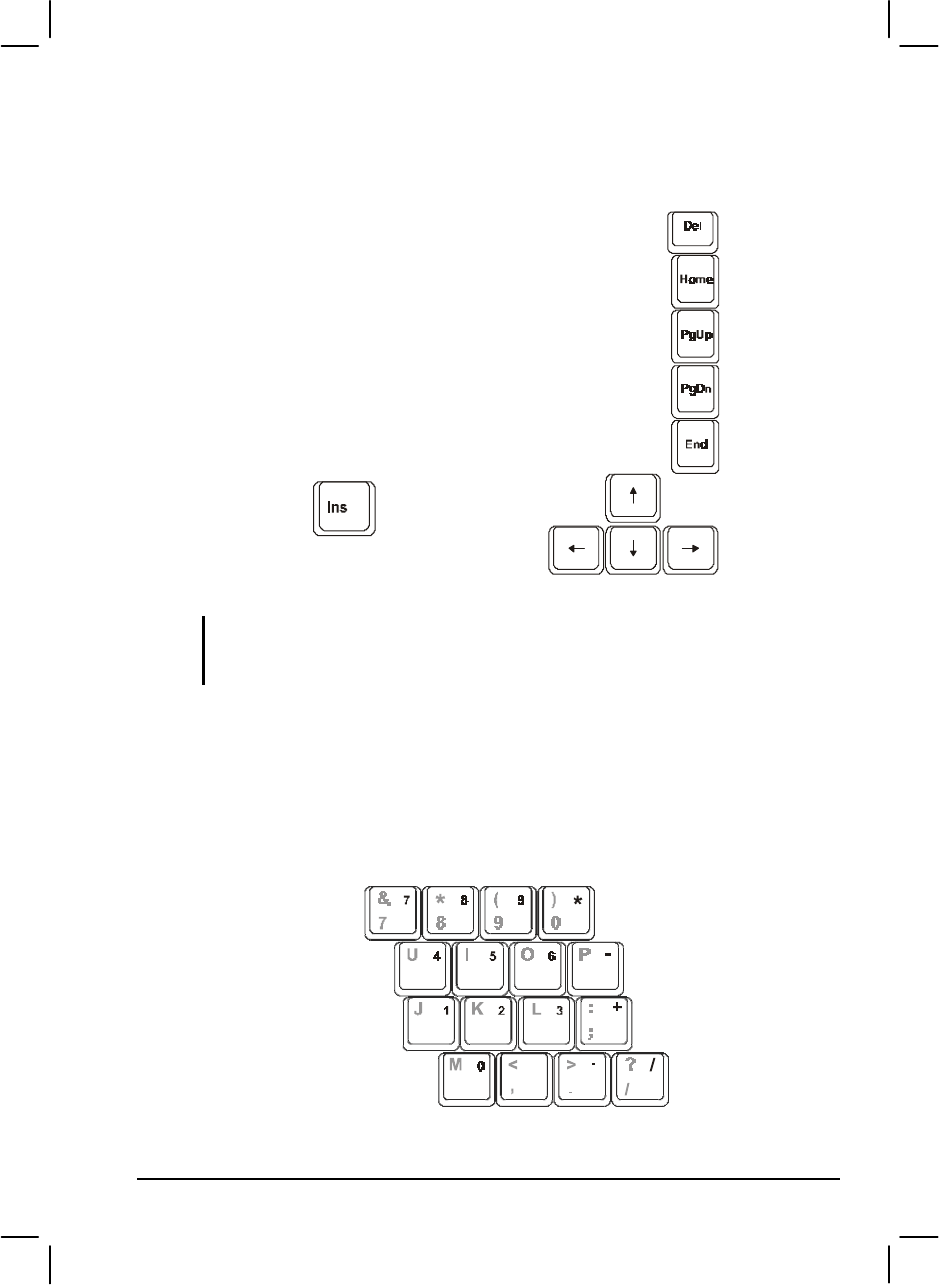
Operating Your Computer 2-5
Cursor-Control Keys
NOTE: The word “cursor” refers to the indicator on the screen that lets you know
exactly where on your screen anything you type will appear. It can take the form of a
vertical or horizontal line, a block, or one of many other shapes.
Numeric Keypad
A 15-key numeric keypad is embedded in the typewriter keys as shown
next:
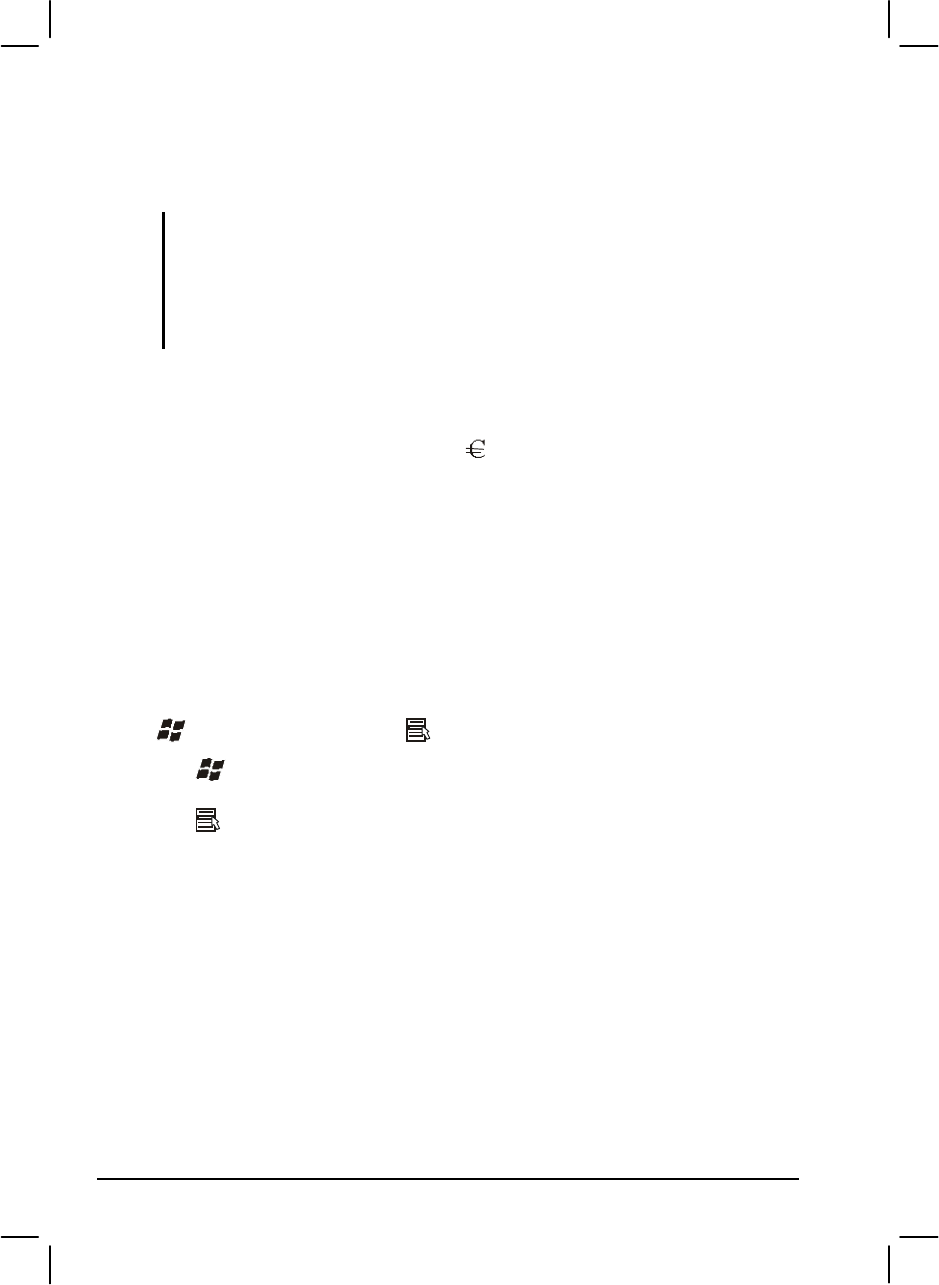
2-6 Operating Your Computer
Numeric keys facilitate entering of numbers and calculations. When Num
Lock is on, the numeric keys are activated; meaning you can use these
keys to enter numerals.
NOTES:
l When the numeric keypad is activated and you need to type the English letter in the
keypad area, you can turn Num Lock off or you can press Fn and then the letter
without turning Num Lock off.
l Some software may not be able to use the numeric keypad on the computer. If so,
use the numeric keypad on an external keyboard instead.
Euro Symbol
You can press the Euro dollar sign on the keyboard.
l To press the Euro sign on the keyboard, hold down either of the Alt
keys and type 0128 on the numeric keypad of your keyboard.
l To press the Euro sign on an UK keyboard, hold down the Alt Gr key
and press 4 (which has an Euro sign on it).
Windows Keys
The keyboard has two keys that perform Windows-specific functions:
Windows Logo key and Application key.
The Windows Logo key opens the Start menu and performs
software-specific functions when used in combination with other keys.
The Application key usually has the same effect as a right mouse
click. (See your Windows manual for more information.)
Function Keys
On the top row of the keys are the function keys: F1 to F12. Function keys
are multi-purpose keys that perform functions defined by individual
programs.
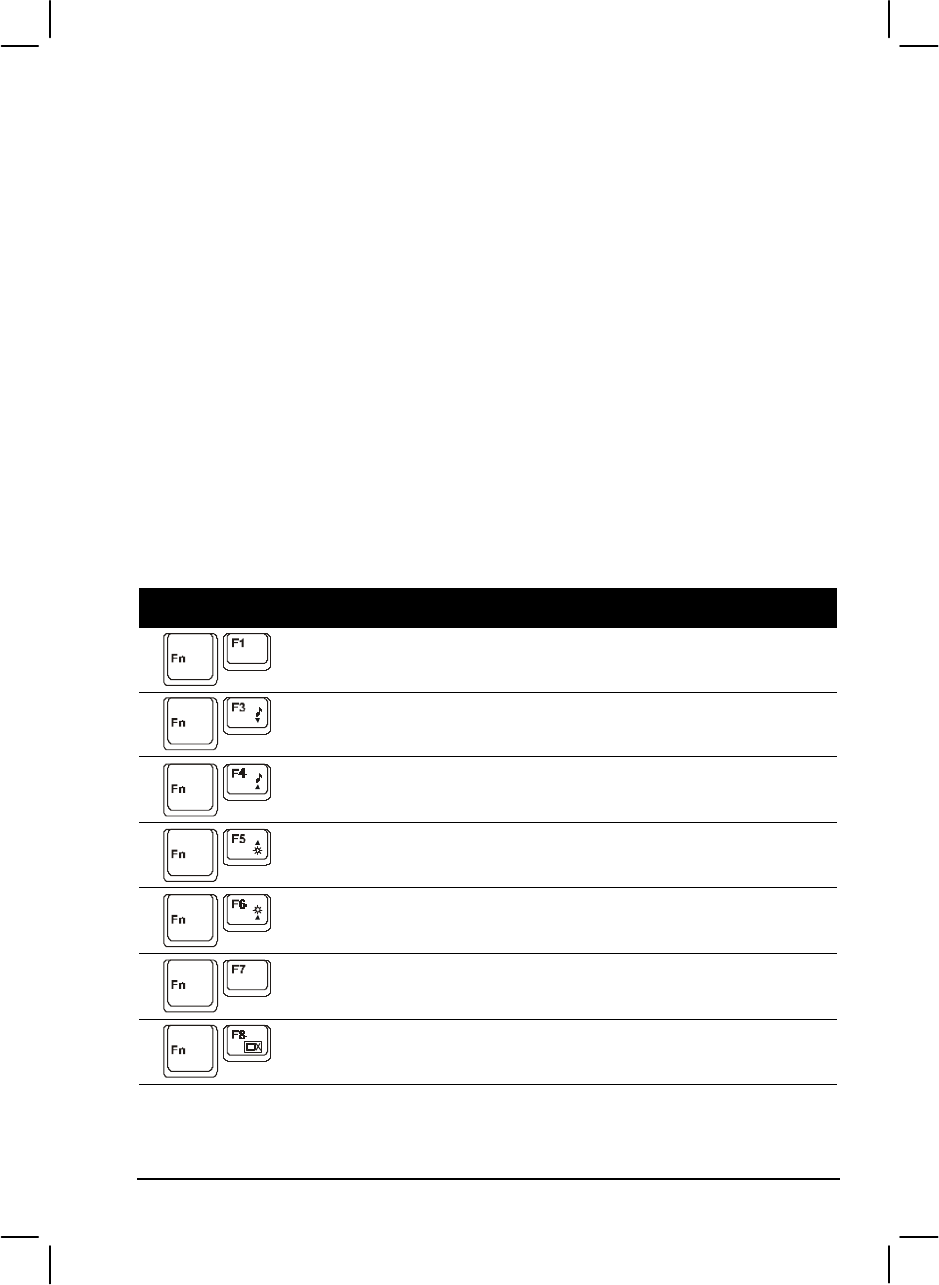
Operating Your Computer 2-7
Fn Key
The Fn key, at the lower left corner of the keyboard, is used with another
key to perform the alternative function of a key. The letter “Fn” and the
alternative functions are identified by the color of blue on the keytop. To
perform a desired function, first press and hold Fn, then press the other
key.
Hot Keys
Hot keys refer to a combination of keys that can be pressed any time to
activate special functions of the computer. Most hot keys operate in a
cyclic way. Each time a hot key combination is pressed, it shifts the
corresponding function to the other or next choice.
You can easily identify the hot keys with the icons imprinted on the
keytop. The hot keys are described next.
Key Description
Switches the optional keyboard backlight function on/off with
10 levels of brightness in-between.
Decreases the sound volume.
Increases the sound volume.
Decreases the LCD brightness.
Increases the LCD brightness.
Enabled/Disabled the Touchpad.
Switches LCD on and off.

2-8 Operating Your Computer
Key Description
Switches the display output to one of the following when an
external device is connected.
Upon booting the system with CRT:
LCD CRT
LCD & CRT
NOTES:
l If the display mode is set to 256 colors or lower, or in DOS
mode, there will be only two modes for selecting: CRT only
and LCD & CRT.
l This function only applies to Plug & Play CRT monitors.
Serves as the sleep button that you can define with Windows’
Power Management. (See the “Power Management” in
Chapter 3.)
Enabled/Disabled the LCD Backlight On/Off.
Switches the optional GPS function on and off.
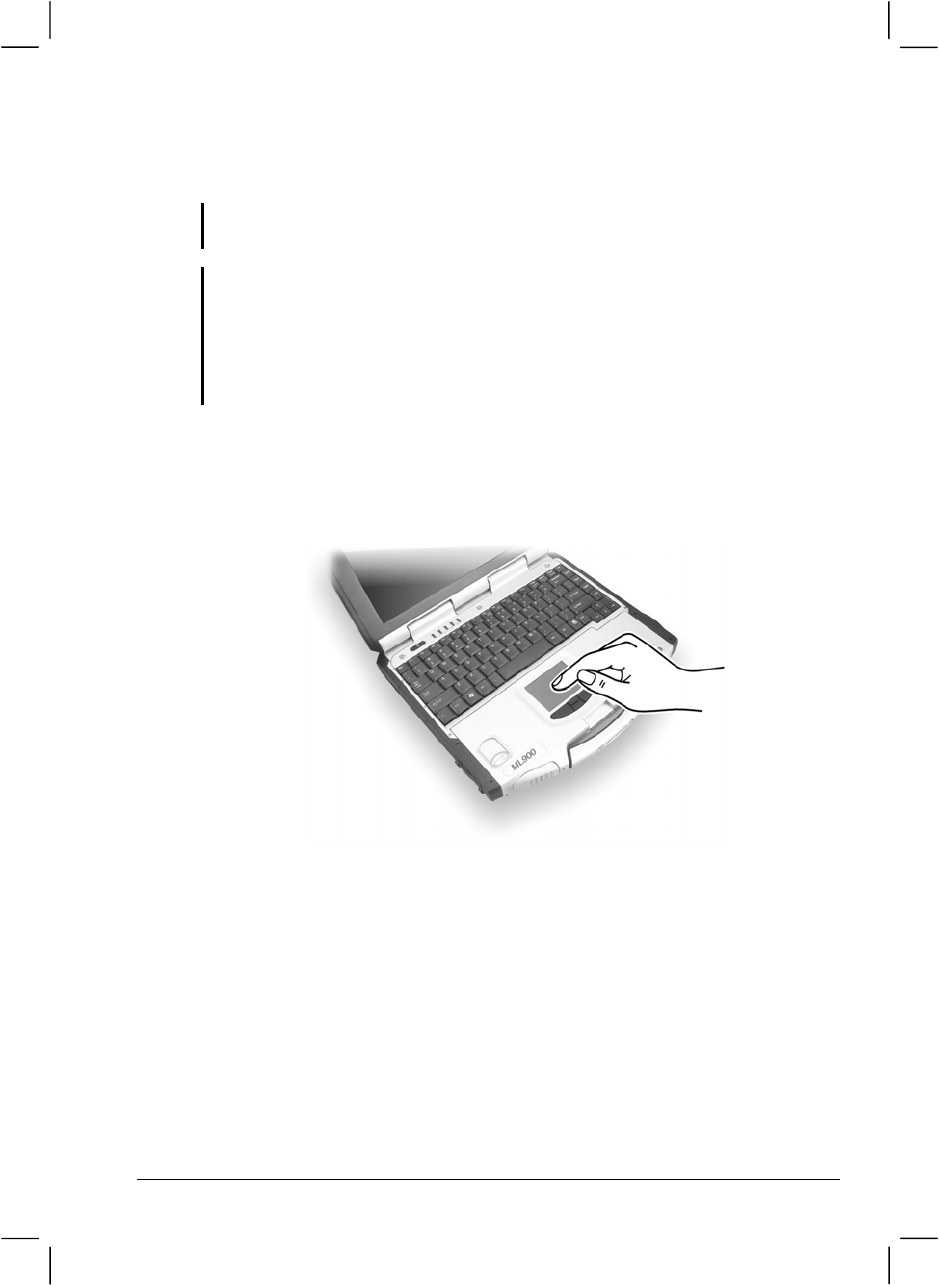
Operating Your Computer 2-9
Using the Touchpad
CAUTION: Do not use a sharp object such as a pen on the touchpad. Doing so may
damage the touchpad surface.
NOTES:
z By default, the touchpad is disabled. Use the Fn+F7 hot keys to enable/disable this
function. The touchpad indicator found on the keyboard panel glows red when it is
disabled.
z For optimal performance of the touchpad, keep your fingers and the pads clean and
dry. When tapping on the pad, tap lightly. Do not use excessive force.
The touchpad is a pointing device that allows you to communicate with
the computer by controlling the location of the pointer on the screen and
making selection with the buttons.
The touchpad consists of a rectangular pad and four buttons. To use the
touchpad, place your forefinger or thumb on the pad. The rectangular pad
acts like a miniature duplicate of your display. As you slide your fingertip
across the pad, the pointer (also called cursor) on the screen moves
accordingly. When your finger reaches the edge of the pad, simply
relocate yourself by lifting the finger and placing it on the other side of
the pad.
Here are some common terms that you should know when using the
touchpad:

2-10 Operating Your Computer
Term Action
Point Move your finger on the pad until the cursor points to the
selection on the screen.
Click Press and release the left button.
–or–
Tap gently anywhere on the pad.
Double-
click Press and release the left button twice in quick succession.
–or–
Tap twice on the pad rapidly.
Drag
and
drop
Press and hold the left button, then move your finger until you
reach your destination (drag). Finally, release the button (drop)
when you finish dragging your selection to the destination. The
object will drop into the new location.
–or–
Gently tap twice on the pad and on the second tap, keep your
finger in contact with the pad. Then, move your finger across the
pad to drag the selected object to your destination. When you lift
your finger from the pad, the selected object will drop into place.
Scroll To scroll is to move up and down or left and right in the working
area on the screen.
The scroll button located between the two buttons under the
touchpad can be used to move vertically in a convenient way.
Press the upper part of the scroll button to move up and the lower
part of the scroll button to move down.
–or–
To move vertically, place your finger on the right edge of the
pad and slide your finger up and down along the edge. To move
horizontally, place your finger on the bottom edge of the pad and
slide your finger left and right.
This function works only after you install the touchpad driver
supplied with the computer and it may not work for all
applications.
TABLE NOTE: If you swap the left and right buttons, “tapping” on the touchpad
as an alternative method of pressing the left button will no longer be valid.

Operating Your Computer 2-11
Configuring the Touchpad
You may want to configure the touchpad to suit your needs. For example,
if you are a left-handed user, you can swap the two buttons so that you
can use the right button as the left button and vise versa. You can also
change the size of the on-screen pointer, the speed of the pointer, and so
on.
To configure the touchpad, you can use the standard Microsoft or IBM
PS/2 driver if you are using Windows. However, you can install the
touchpad driver supplied with your computer to take advantage of more
powerful features. (For information on installing the driver, see “How to
Use the Driver CD” in Chapter 6.)

2-12 Operating Your Computer
Using the Touchscreen (option)
CAUTION: Do not use a sharp object such as a ballpoint pen or pencil on the
touchscreen. Doing so may damage the touchscreen surface.
The touchscreen is a touch-sensitive device that allows you to
communicate with the computer by controlling the location of the pointer
on the screen and making selection with the buttons.
The touchscreen needs a special device driver support that allows you to
easily use the computer without a mouse or touchpad. (For information
on installing the driver, see Chapter 6.)
Here are some common terms that you should know when using the
touchscreen:
Term Action
Click/Point Tap gently on the touchscreen.
Double-click Tap twice on the touchscreen rapidly.
Drag and
drop Press lightly on the touchscreen and move your finger
until you reach your destination (drag). Finally, release
your finger (drop) when you finish dragging your selection
to the destination. The object will drop into the new
location.
Scroll To scroll is to move up and down or left and right in the
working area on the screen.
To move vertically, place your finger on the right edge of
the touchscreen and slide your finger up and down along
the edge. To move horizontally, place your finger on the
bottom edge of the touchscreen and slide your finger left
and right.
This function works only after you install the touchscreen
driver supplied with the computer and it may not work for
all applications.
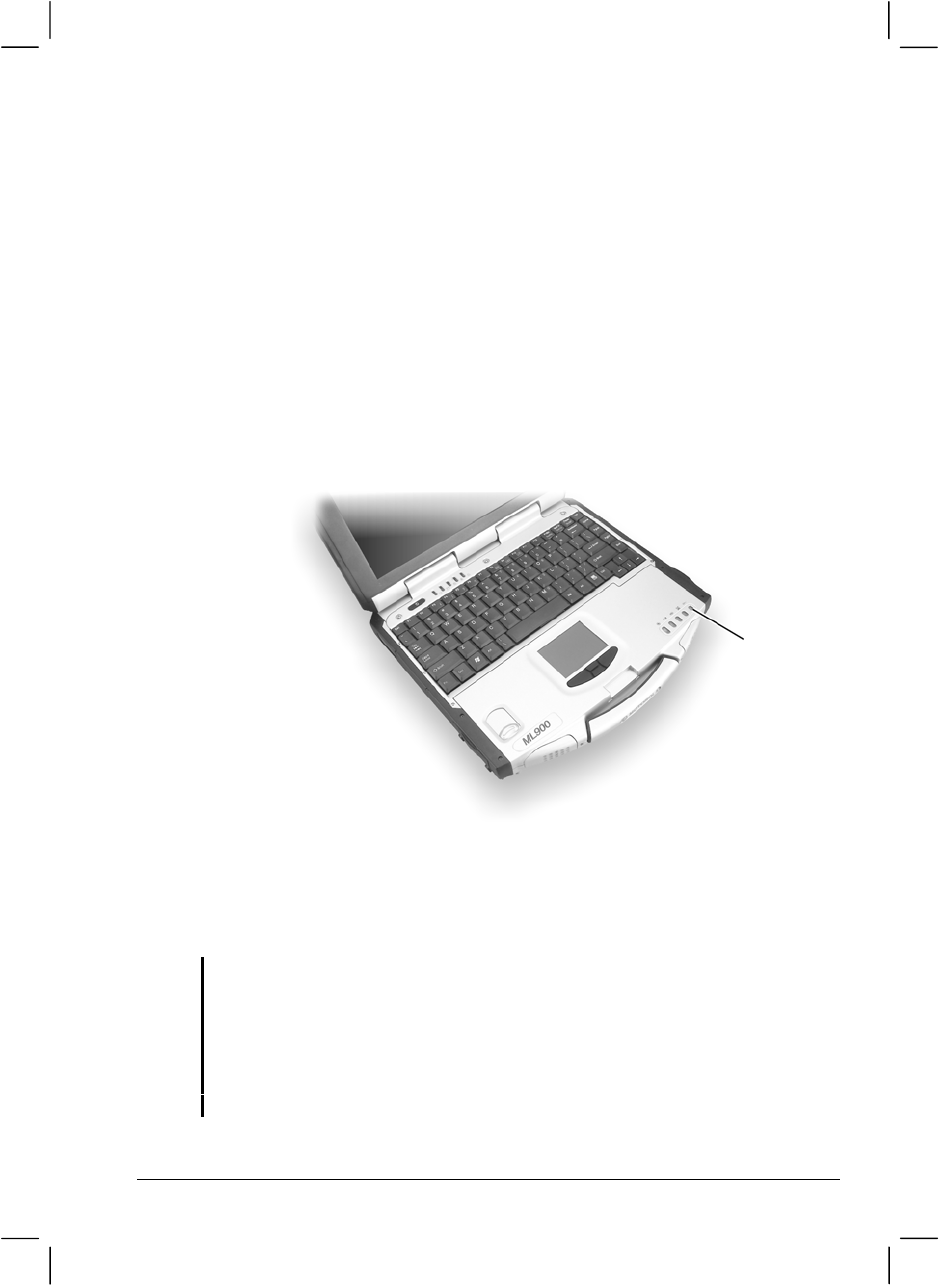
Operating Your Computer 2-13
Using the Hard Disk Drive
Your computer comes with a hard disk drive as drive C. A hard disk drive
is a storage device with non-removable, rotating, magnetic storage
platters inside it. It is where your operating system and application
software programs are stored.
Your hard disk drive is a 2.5-inch IDE (Integrated Drive Electronics) hard
disk drive. This type of drive embodies the latest in fast, reliable mass
storage by integrating all the control circuitry necessary for operation
directly onto the drive itself. This allows the drive manufacturer to
carefully optimize drive performance.
The system comes with a built-in heater that automatically turns on for
low temperature operation. The AC in / HDD heater on indicator blinks
red when heater is on.
CAUTION:
z Make regular backups of your data files from your hard disk drive to floppy disks or
other storage media.
z Never try to remove or install the hard disk drive while the computer is powered on.
Doing so can result in loss of data, and can damage the computer and the hard disk
drive’s sensitive circuitry.
z Never turn off or reset the computer while the hard disk drive in-use indicator is on.
AC in /
HDD heater on
indicator
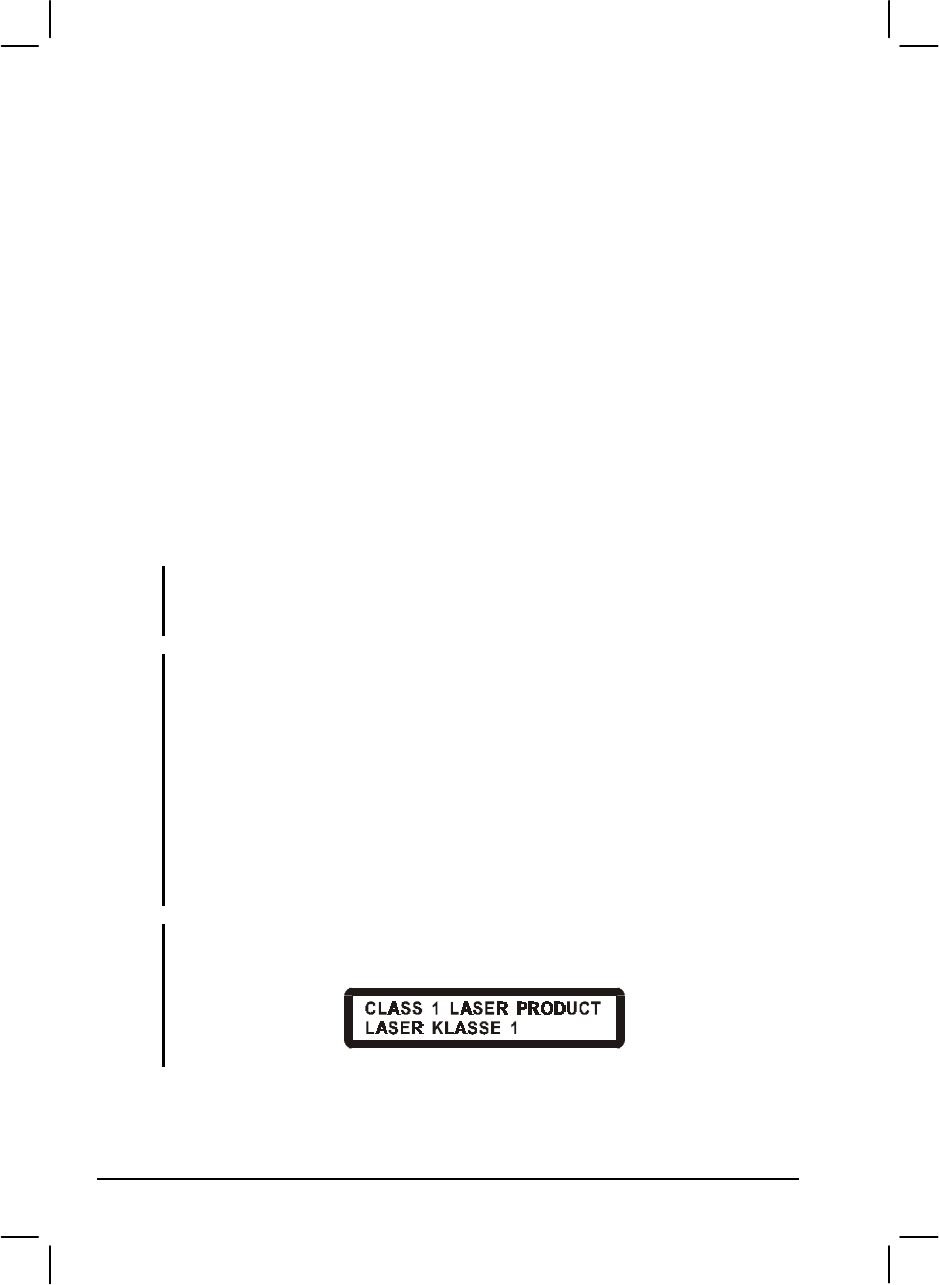
2-14 Operating Your Computer
Using the CD/DVD/Combo Drive
Depending on the model, your computer comes with a CD, DVD or
Combo drive located on the right side of the computer. This drive is
usually configured as drive D.
The drive uses removable 5.25-inch silver discs, which look like standard
music CDs. It is an ideal medium to use for distributing multimedia
because of the huge amount of data that a disc can store.
Depending on the model, your drive is one of the following:
l CD drive can read CDs, audio CDs, CD-R, and CD-RW discs.
l DVD drive can read DVD (Digital Versatile Disc) discs in addition
to the above discs.
l Combo drive can work both as a DVD drive and CD-RW drive.
NOTE: If the CD/DVD/Combo drive would be operating for more than half an hour
(such as showing a DVD title), use the AC power source instead of the battery. If not,
the battery may run out of power before the operation is complete.
CAUTION:
1. When inserting a CD, do not use force.
2. Make sure the CD is correctly inserted into the tray, and then close the tray.
3. Do not leave the CD tray open. Also, avoid touching the lens in the tray with your
hand. If the lens becomes dirty, the CD may malfunction.
4. Do not wipe the lens using materials with rough surface (such as paper towel).
Instead, use a cotton swab to gently wipe the lens.
FDA regulations require the following statement for all laser-based devices:
“Caution, Use of controls or adjustments or performance of procedures other than
those specified herein may result in hazardous radiation exposure.”
NOTE: The CD/DVD/Combo drive is classified as a Class 1 laser product. This label is
located on the CD/DVD/Combo drive.
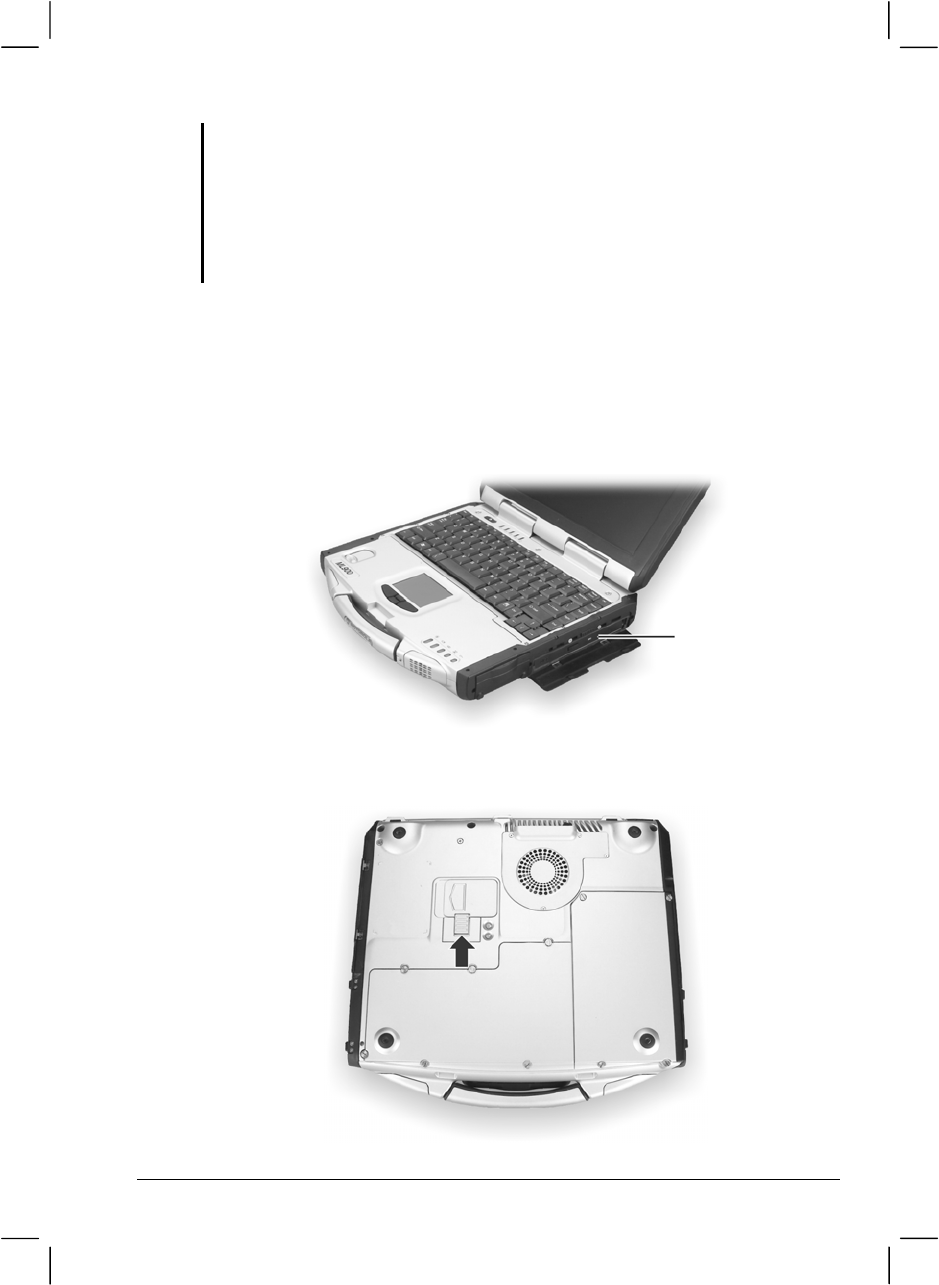
Operating Your Computer 2-15
NOTE: For DVD/Combo drive only.
This product incorporates copyright protection technology that is protected by method
claims of certain U.S. patents and other intellectual property rights owned by
Macrovision Corporation and other rights owners. Use of this copyright protection
technology must be authorized by Macrovision Corporation, and is intended for home
and other limited viewing uses only unless otherwise authorized by Macrovision
Corporation. Reverse engineering or disassembly is prohibited.
Installing the CD/DVD/Combo Drive
To install the CD/DVD/Combo drive:
1. Insert the CD/DVD/Combo drive into the CD drive bay located on
the right side of the computer.
2. Slide the CD drive lock/unlock switch to the lock position to secure
the CD/DVD/Combo drive in place.
CD drive
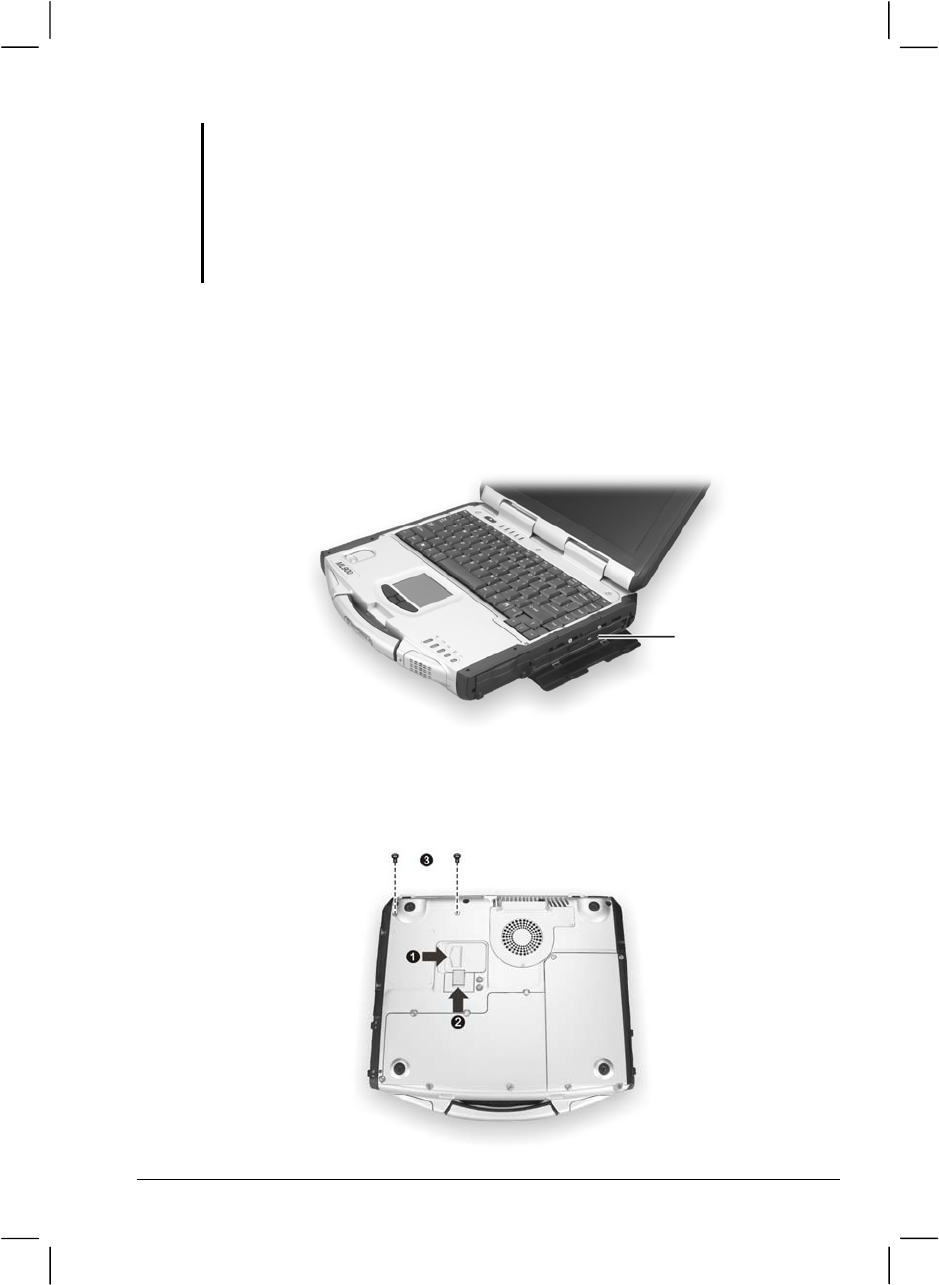
Operating Your Computer 2-15
NOTE: For DVD/Combo drive only.
This product incorporates copyright protection technology that is protected by method
claims of certain U.S. patents and other intellectual property rights owned by
Macrovision Corporation and other rights owners. Use of this copyright protection
technology must be authorized by Macrovision Corporation, and is intended for home
and other limited viewing uses only unless otherwise authorized by Macrovision
Corporation. Reverse engineering or disassembly is prohibited.
Installing the CD/DVD/Combo Drive
To install the CD/DVD/Combo drive:
1. Insert the CD/DVD/Combo drive into the CD drive bay located on
the right side of the computer.
2. Slide the CD drive lock/unlock switch to the lock position (o) and
secure the two screws (p) to fix the CD/DVD/Combo drive in place.
CD drive
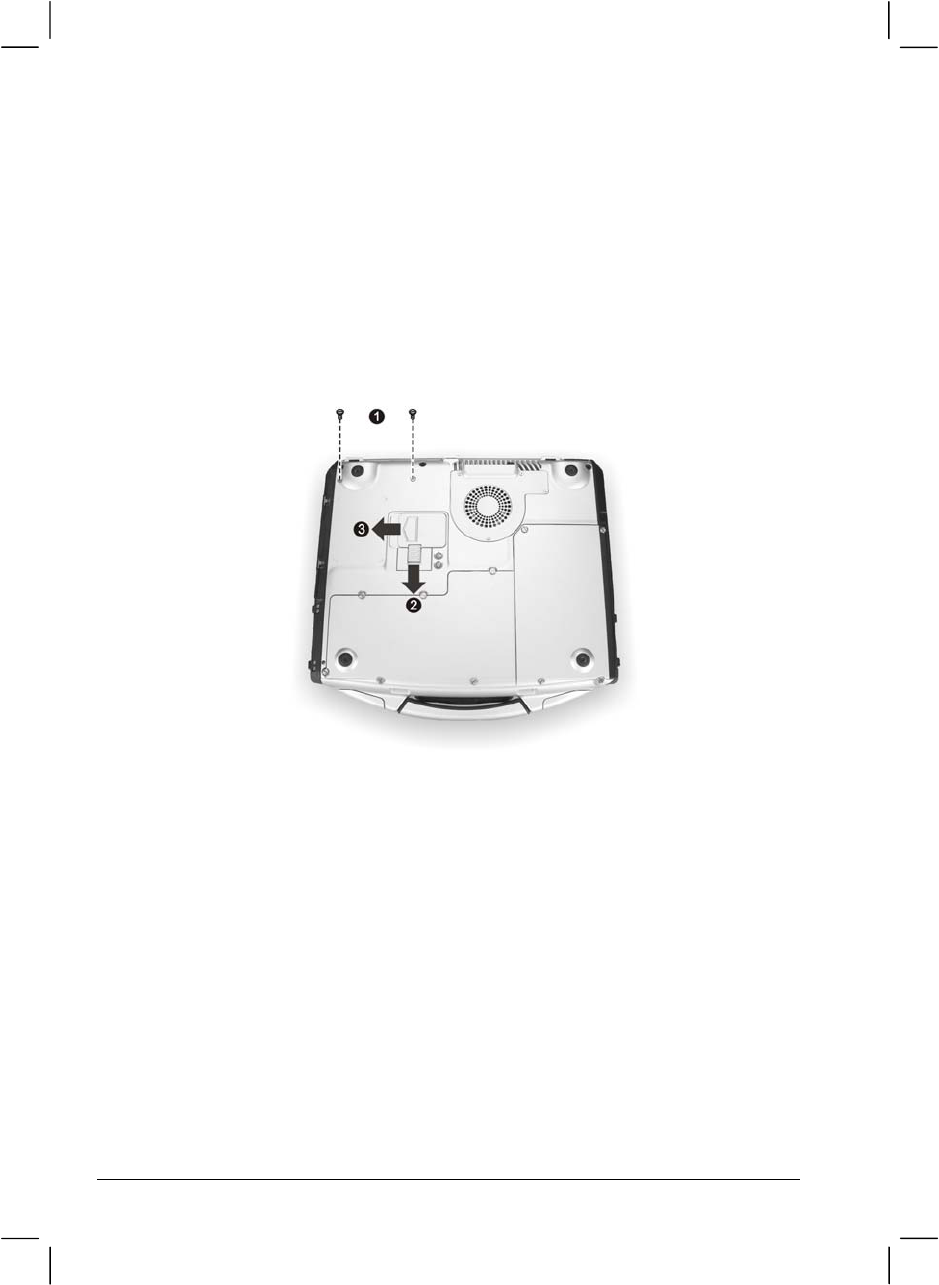
2-16 Operating Your Computer
Removing the CD/DVD/Combo Drive
To remove the CD/DVD/Combo drive:
1. Remove the two screws (n).
2. Slide the CD drive lock/unlock switch to the unlock position (o) and
pull the CD/DVD/Combo drive out of the CD drive bay (p).
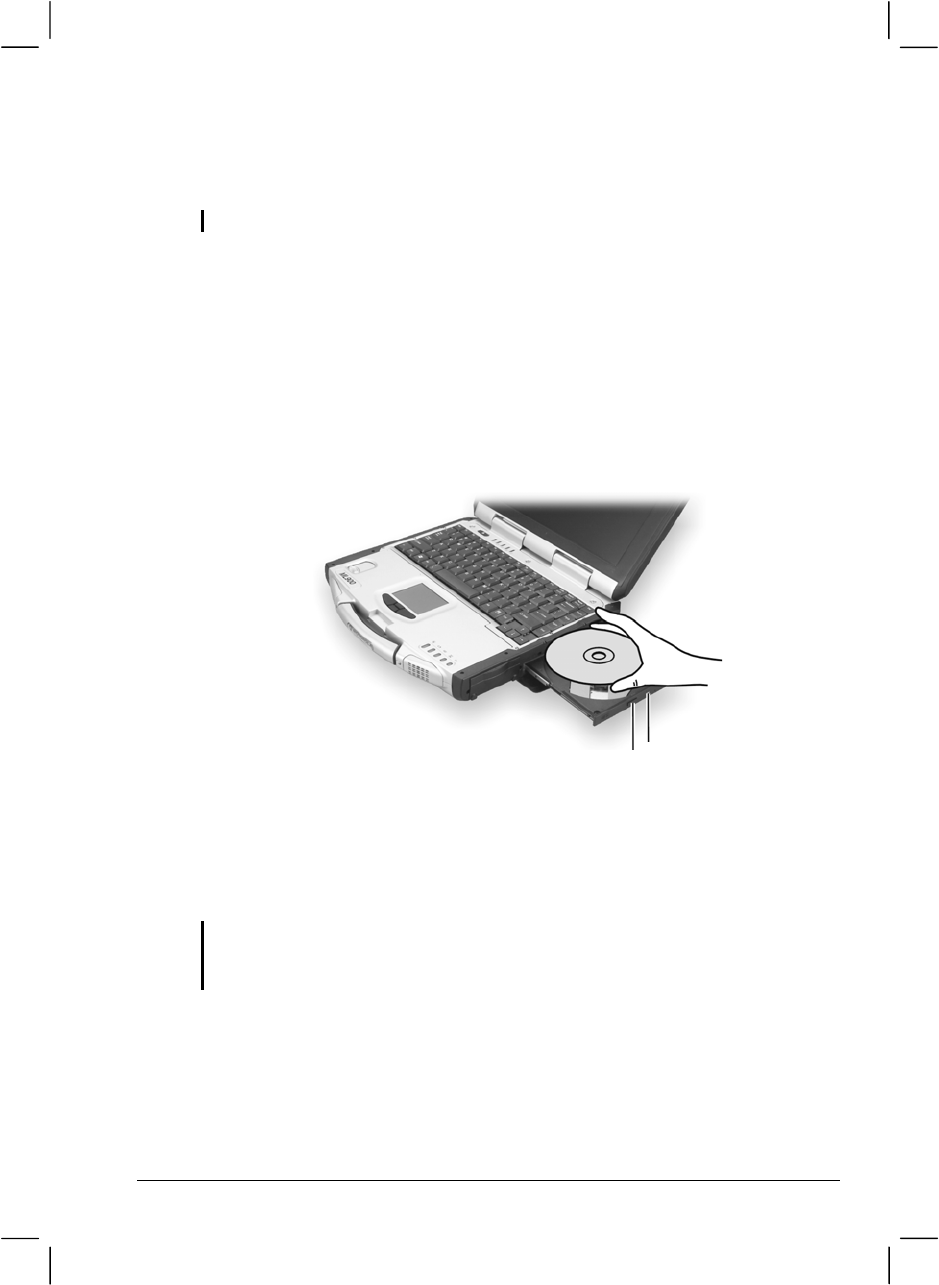
2-16-1 Operating Your Computer
Inserting and Removing a CD
NOTE: The following procedure applies to inserting or removing a DVD disc as well.
Follow this procedure to insert or remove a CD.
1. Turn on the computer.
2. Press the eject button and the CD tray will slide out partially. Gently
pull on it until it is fully extended.
3. To insert a CD, place down the CD in the tray with its label facing up.
Slightly press the center of the CD until it clicks into place.
To remove a CD, hold the CD by its outer edge and lift it up from the
tray.
4. Gently push the tray back into the drive.
NOTE: In the unlikely event that you are unable to release the CD tray by pressing the
eject button, you can manually release the CD. (See “CD/DVD/Combo Drive Problems”
in Chapter 8.)
Eject button In-use
indicator

Operating Your Computer 2-17
Using the Video Features
The video subsystem of your computer features:
l 12.1/13.3-inch TFT (Thin-Film Transistor) color LCD display with
1024x768 XGA (Extended Video Graphics Array) resolution.
l 64 MB integrated video memory.
l Simultaneous display on LCD and external monitor, which is useful
when you have a presentation as you can control the screen from your
computer and face the audience at the same time.
l Dual view capability, which allows you to expand your desktop on
the screen to another display device so that you have more desktop
space to work on.
l Power Management.
l Touchscreen function (option).
l Sunlight readable transflective LCD display (option).
NOTES:
l Before using the dual view capability, the video driver supplied with your computer
must be installed.
l The computer enters Standby or Hibernation mode when the LCD is closed. If you
want to use the computer with the LCD closed, set None to the “When I close the lid
of my portable computer” option in the Power Management Properties. Thus the
computer does not enter Standby or Hibernation mode when the LCD is closed.
Configuring the Display Modes
NOTES:
l To take advantage of the enhanced video capabilities, the video driver supplied
with your computer must be installed.
l When using CRT only, the resolution would depend on the supported resolution by
the CRT.

Ope Operating Your Computer
2-18
Your computer has been set to a default resolution and number of colors
before shipment. You can view and change display settings through your
operating system. See your operating system documentation or online
help for specific information.
For displaying in higher resolutions, you can connect an external CRT
monitor that supports higher resolutions. (See “Connecting an External
Monitor” in Chapter 4 for more information.)
The following table lists the display modes supported by your computer.
Display Mode LCD Only CRT Only Simultaneous Display
Resolution Colors
16-bit √√ √
800x600
32-bit √√ √
16-bit √√ √
1024x768
32-bit √√ √
TABLE NOTES:
z 16-bit = High Color or 65,536 (64 K) colors; 32-bit = True Color 16,770,000 (16 M)
colors.
z When using CRT only, the resolution would depend on the supported resolution by
the CRT.
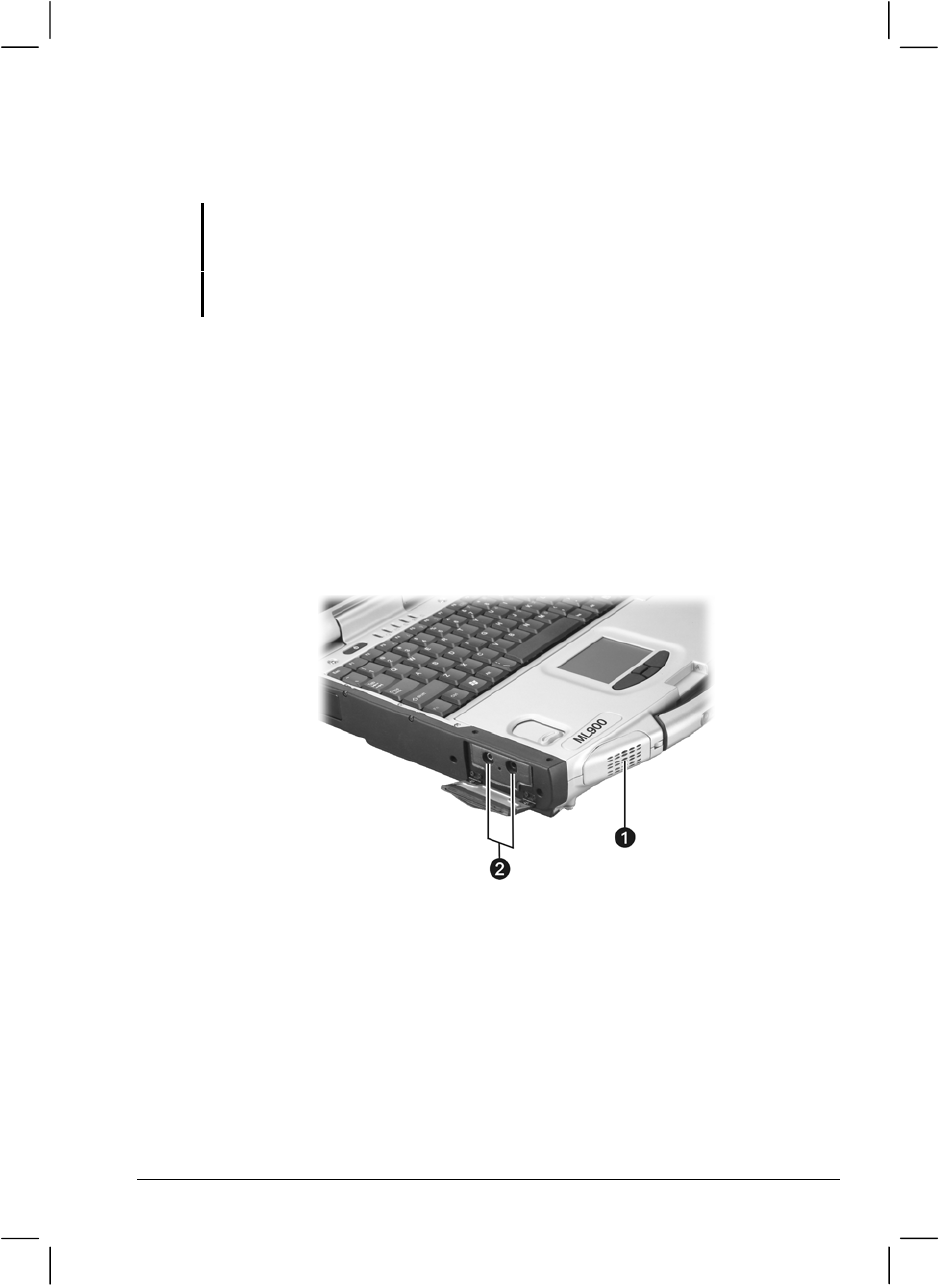
Operating Your Computer 2-19
Using the Audio Features
NOTES:
z To take advantage of the enhanced audio capabilities, the audio driver supplied
with your computer must be installed (see chapter 6 for details).
z If you experience interference while recording, try lowering the microphone
recording volume.
The audio subsystem of your computer features:
z Digital audio and analog mixing functions required for recording and
playing sound on your computer
z Microsoft Windows Sound System support
z A set of speakers (n)
z External audio connectors (o)
Ways of playing and recording sound vary with the operating system
used. See your operating system documentation or online help for
specific information.

2-20 Operating Your Computer
Connecting Audio Devices
For higher audio quality, you can send or receive sound through external
audio devices.
l Microphone Connector ( ) can be connected to an external
microphone for recording voice or sound.
l Audio Output Connector ( ) can be connected to the line-in
connector of powered speakers with built-in amplifiers, headphones,
or earphone set. This connector is compliant with S/P-DIF
(Sony/Philips-Digital InterFace). You can connect audio equipment
with S/P-DIF to the computer. S/P-DIF is a new audio transfer file
format that ensures a high quality digital audio output through optical
fibers.
NOTE: When using external speakers/headphones or microphone, you cannot use the
internal one.
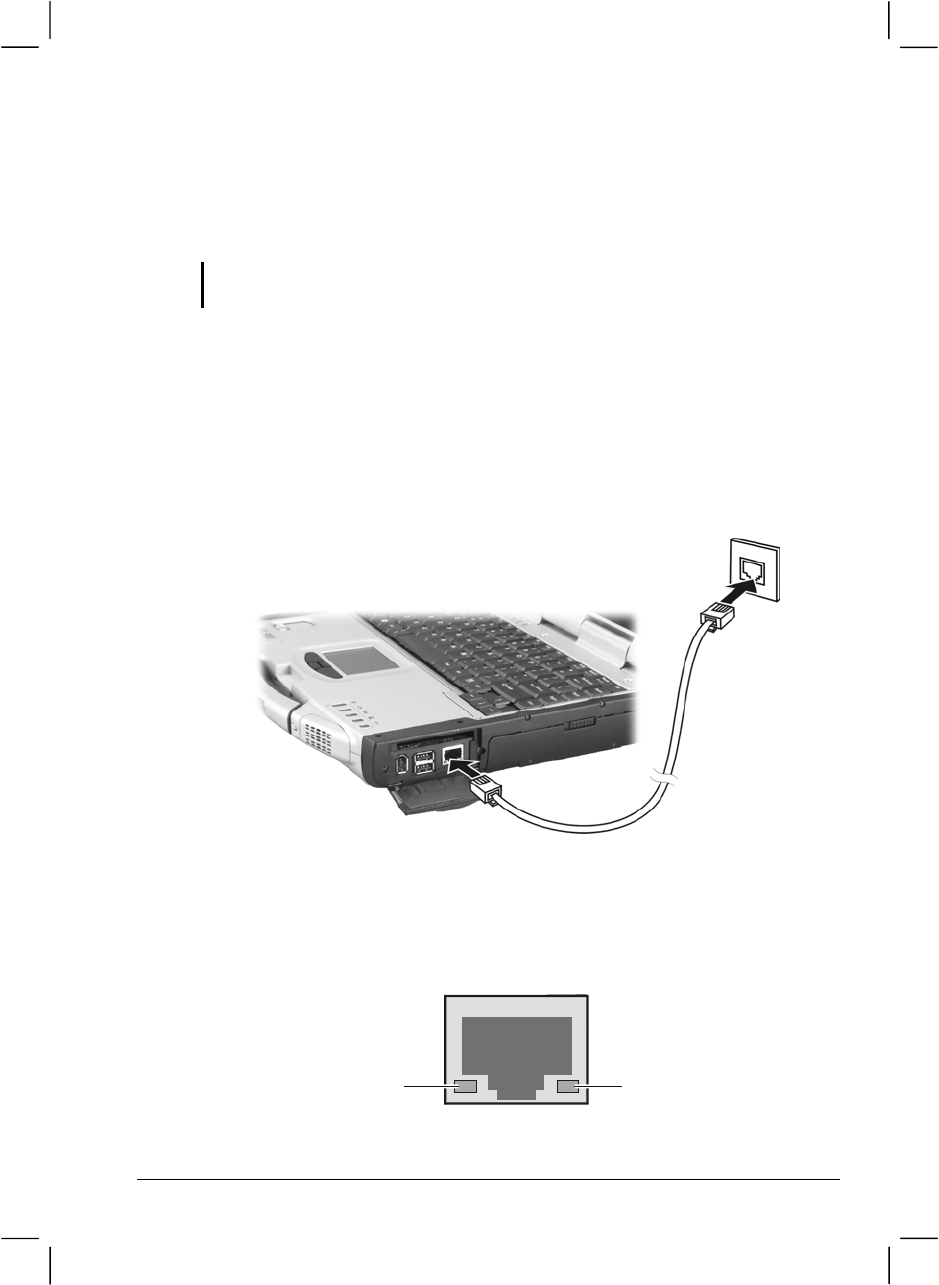
Operating Your Computer 2-21
Using the Communication Features
Using the LAN
NOTE for Windows 2000: To take advantage of the LAN feature, the LAN driver
supplied with your computer must be installed.
The internal 100Base-T LAN (Local Area Network) module allows you
to connect your computer to a network. It supports data transfer rate up to
100 Mbps.
To connect the network cable to the LAN module, connect one end of the
LAN cable to the RJ-45 connector on the computer and the other end to
the network hub.
Link Indicator Glows green when the system has an available
connection to LAN.
Active Indicator Blinks green when the system is accessing the LAN.
Active
indicator
Link
indicator

2-22 Operating Your Computer
Using the Wireless LAN
Depending on your model, an internal Mini PCI wireless LAN (WLAN)
card may have been pre-installed by your computer manufacturer at the
factory. This card allows you to access corporate networks or the Internet
in a wireless environment.
The WLAN features include:
l IEEE 802.11b standard compliance
l 2.4 GHz DSSS (Direct Sequence Spread Spectrum) technology
l Peer-to-Peer (Ad-Hoc) and Access Point (Infrastructure) modes
support
l WEP (Wired Equivalent Privacy) 64/128-bit data encryption
l Transmission rate at 11 Mbps, 5.5 Mbps, 2 Mbps, and 1 Mbps with
automatic data rating
To take advantage of the WLAN feature, make sure that the WLAN
driver is installed correctly. (See Chapter 6 for more information.) If your
WLAN card was provided by your dealer instead of the computer
manufacturer, contact your dealer for the correct driver to use.
Configuring the WLAN
After driver installation, you can use the WLAN utility to configure and
monitor your WLAN connection. If you are using Windows XP, you can
also use its built-in WLAN utility. Follow this procedure to launch the
WLAN utility in Windows XP:
1. Select Control Panel from the Start menu.
2. Click Network and Internet Connections.
3. Click Network Connections, then double-click the Wireless
Network Connection icon .
4. Click Properties in the Wireless Network Connection Status
dialog box.
5. You can configure your WLAN settings in the Wireless Network
Connection Properties dialog box.

Operating Your Computer 2-23
NOTE: The FAA (Federal Aviation Agency) has deemed it unsafe to operate wireless
devices in aircraft as this may interfere with flight safety. Remember to select turn off
wireless LAN when using your computer in the airplane.
Replacing the Wireless LAN
To replace the Wireless LAN, follow these steps:
1. Make sure the computer is not turned on or connected AC power.
2. Remove the 6 screws of the HDD cover and lift the Mini PCI Wireless
module to take it off the computer.
Using the Wireless Modem
Depending on your model, your computer includes an integrated GSM
(Global System for Mobile Communications) / GPRS (General Packet
Radio Service) feature.
After you establish a subscription with a GSM/GPRS service provider,
you can use the wireless data features of your computer. Check with your
service provider for a list of available wireless data services. Your service
provider may charge additional fees for use of data services.
There are two methods for wirelessly connecting to an ISP or network:
l GSM data transmission (circuit-switched data)
GSM data services enable you to use the GSM component of your
computer as a built-in modem. You can use the service to connect to
the Internet through an ISP or dial in to a corporate network to browse
the Web or send and receive e-mail messages.
l GPRS data transmission
GPRS is a high-speed data-on service that enables you to transmit
data over a mobile network. Subscribing to a GPRS service allows
you to transfer files, browse the Web and receive streaming audio and
video on your computer.
Connecting Using the GSM Modem
NOTE: To take advantage of the wireless modem feature, the PCI-952 driver supplied
with your computer must be installed (see chapter 6).

2-24 Operating Your Computer
Your computer can send and receive data via a mobile network using the
GSM protocol.
To send or receive data over a GSM network, you must have an account
with a service provider that supports GSM data services, and the service
provider must enable the data features on your account.
Configuring a GSM Modem Connection
Before you can use the GSM modem connection, make sure that you have
a subscription to the Circuit-Switched Data (CSD) network with your
service provider and you have an account with your service provider or
corporate network you are connecting to.
To connect to an ISP or dial in to a specific computer, you must configure
a connection for that service on your computer.
Connecting Using GPRS
Your computer can receive General Packet Radio Services (GPRS), a
high-speed data-only service that transmits data over a mobile telephone
network. In addition, GPRS provides permanent on-line connection.
To use GPRS, you must have a subscription to the function with a service
provider that supports GPRS.
Configuring a GPRS Connection
To connect to a GPRS network, you must configure a connection for that
service on your computer.
Using the GPS
NOTE: To take advantage of the GPS feature, the PCI-952 driver supplied with your
computer must be installed (see chapter 6).
Navigation and positioning are crucial to so many activities and yet the
process has always been quite cumbersome. To try to figure out where
you are and where you are going, you need GPS technology.
The Global Positioning System (GPS) is a worldwide radio-navigation
system formed from a constellation of 24 satellites and their ground

Operating Your Computer 2-25
stations. GPS uses these "man-made stars" as reference points to calculate
positions accurate to a matter of meters. In fact, with advanced forms of
GPS you can make measurements to better than a centimeter! In a sense it
is like giving every square meter on the planet a unique address.
Here's how GPS works in five logical steps:
l The basis of GPS is "triangulation" from satellites.
l To "triangulate," a GPS receiver measures distance using the travel
time of radio signals.
l To measure travel time, GPS needs very accurate timing that it
achieves with some tricks.
l Along with distance, you need to know exactly where the satellites
are in space. High orbits and careful monitoring are the secret.
l Finally you must correct for any delays the signal experiences as it
travels through the atmosphere.
Five broad categories of GPS application:
l Location – determining a basic position
l Navigation – getting from one location to another
l Tracking – monitoring the movement of people and things
l Mapping – creating maps of the world
l Timing – bringing precise timing to the world

2-26 Operating Your Computer

CHAPTER 3
Managing Power
Your computer operates either on external AC power or internal battery
power.
This chapter tells you how you can effectively manage power. To
maintain optimal battery performance, it is important that you use the
battery in the proper way.
The topics in this chapter include:
l What is an AC adapter
l How to charge the battery pack
l When and how to initialize the battery pack
l How to check the battery level
l How to replace the battery pack
l What happens when the battery is low and what actions to take
l What is Power Management
l How to save power

3-2 Managing Power
AC Adapter
CAUTION:
l The AC adapter is designed for use with your computer only. Connecting the AC
adapter to another device can damage the adapter.
l The AC power cord supplied with your computer is for use in the country where you
purchased your computer. If you plan to go overseas with the computer, consult
your dealer for the appropriate power cord.
l When you disconnect the AC adapter, disconnect from the electrical outlet first and
then from the computer. A reverse procedure may damage the AC adapter or
computer.
l When unplugging the connector, always hold the plug head. Never pull on the cord.
The AC adapter serves as a converter from AC (Alternating Current) to
DC (Direct Current) power because your computer runs on DC power,
but an electrical outlet usually provides AC power. It also charges the
battery pack when connected to AC power.
The AC adapter operates on any voltage in the range of 100 ~ 240 V AC.
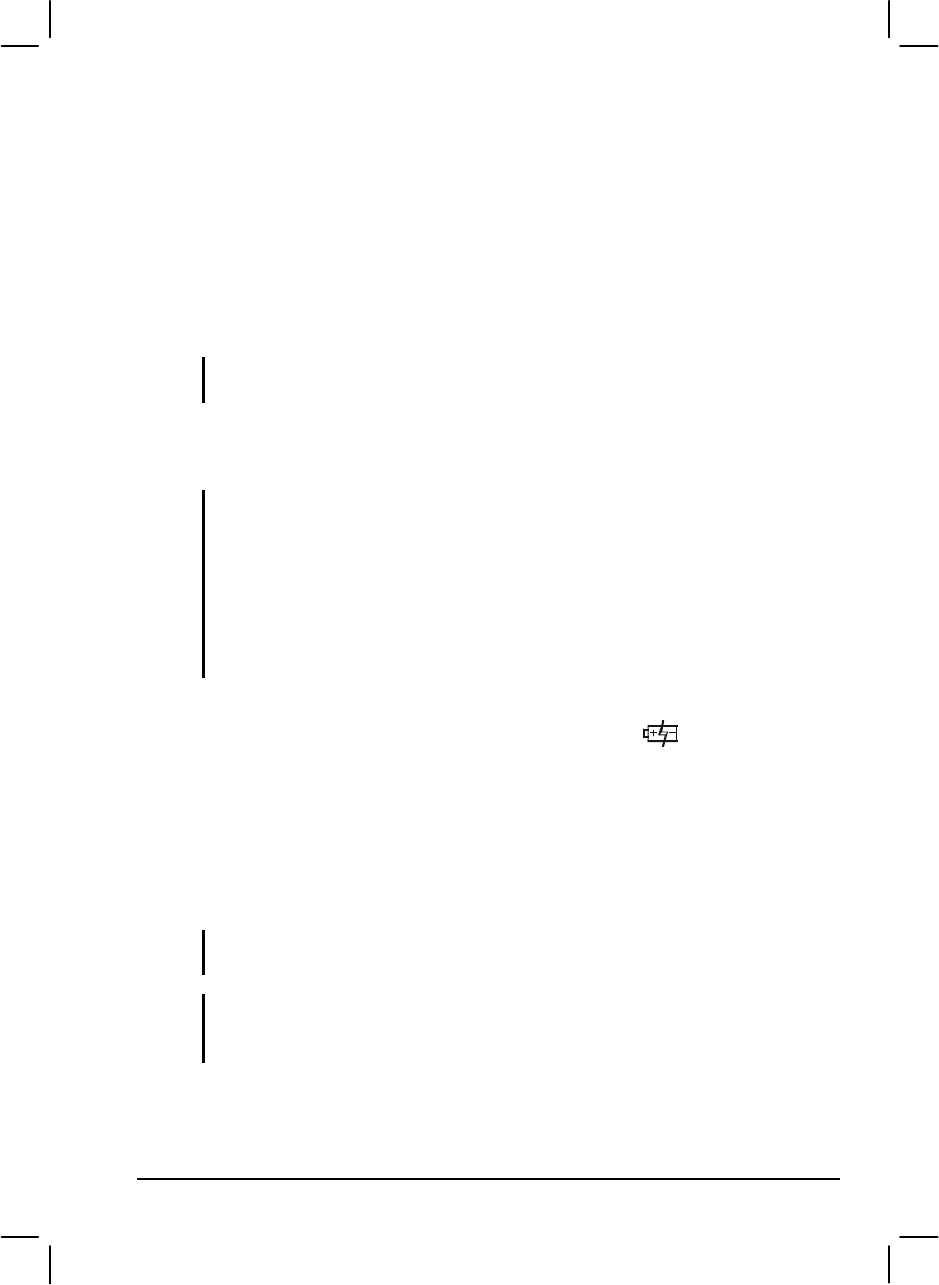
Managing Power 3-3
Battery Pack
The battery pack is the internal power source for the computer. It is
rechargeable using the AC adapter.
The operating time of a fully charged battery pack depends on how you
are using the computer. When your applications often access peripherals,
you will experience a shorter operating time.
NOTE: Care and maintenance information for the battery is provided in the “Battery
Pack Guidelines” section in Chapter 7.
Charging the Battery Pack
NOTES:
l Charging will not start if the battery’s temperature is below 0 °C (32 °F) or above 50
°C (122 °F).
l The charging process will stop and the Battery Charge Indicator flashes amber
when the battery’s temperature gets above 60 °C (140 °F). If this happens, the
battery pack may be damaged. Please contact your dealer.
l During charging, do not disconnect the AC adapter before the battery has been fully
charged; otherwise you will get a prematurely charged battery.
To charge the battery pack, connect the AC adapter to the computer and
an electrical outlet. The Battery Charge Indicator ( ) on the computer
glows amber to indicate that charging is in progress. You are advised to
keep the computer power off while the battery is being charged. When the
battery is fully charged, the Battery Charge Indicator glows green.
It takes approximately 197 minutes to charge the battery pack to 80%
capacity and four or more hours to fully charge the battery pack when the
computer is off.
CAUTION: After the computer has been fully recharged, do not immediately disconnect
and reconnect the AC adapter to charge it again. Doing so may damage the battery.
NOTE: The battery level may automatically lessen due to the self-discharge process
(0.21% per day), even when the battery pack is fully charged (100%). This happens no
matter if the battery pack is installed in the computer.
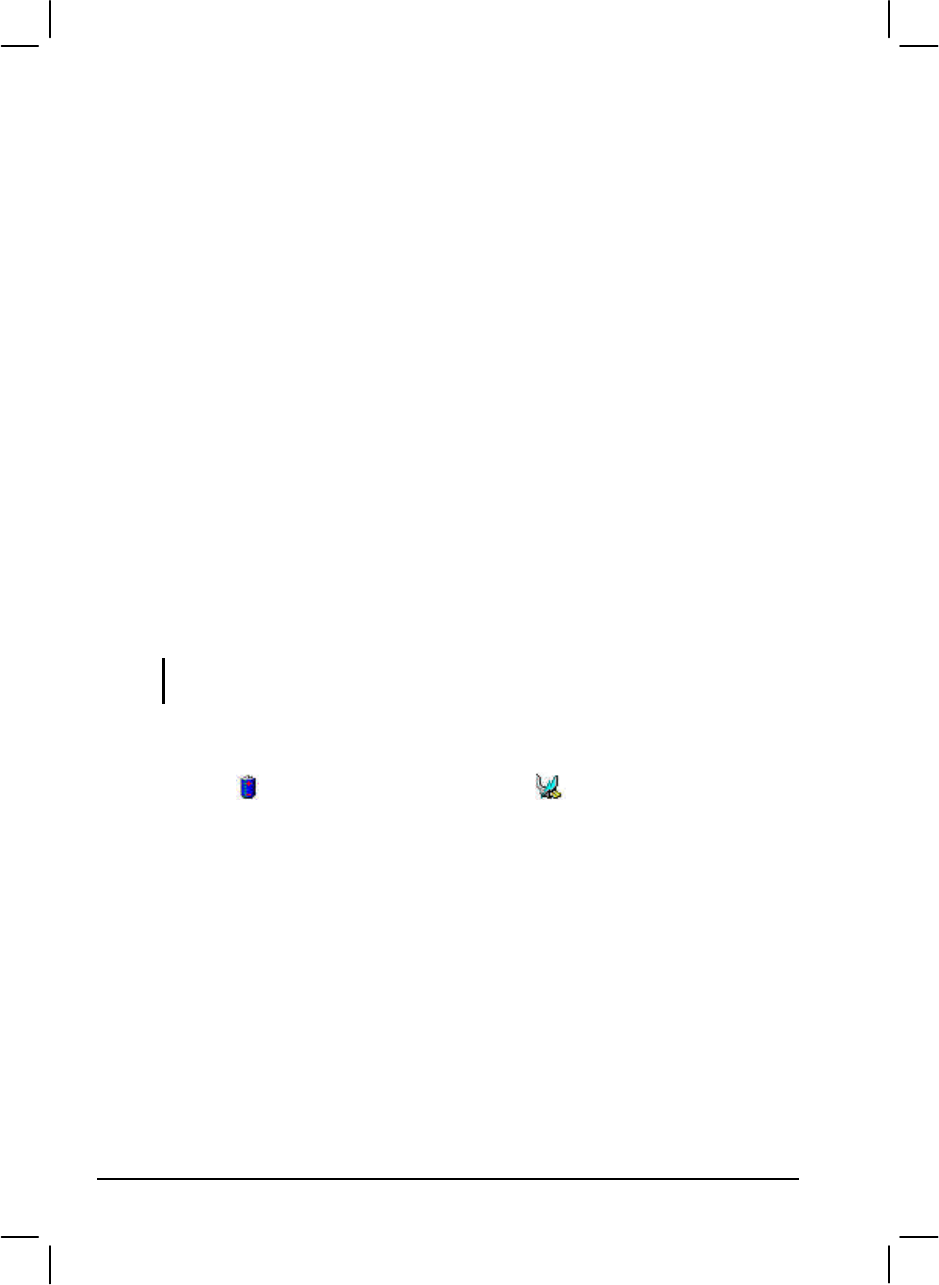
3-4 Managing Power
Initializing the Battery Pack
You need to initialize a new battery pack before using it for the first time
or when the actual operating time of a battery pack is much less than
expected.
Initializing is the process of fully charging, discharging, and then
charging. It can take several hours.
1. Make sure the computer power is turned off. Connect the AC adapter
to fully charge the battery pack.
2. After the battery pack is fully charged, turn on the computer.
3. Disconnect the AC adapter and leave the computer on until the
battery is fully discharged. The computer will shut down
automatically.
4. Connect the AC adapter to fully charge the battery pack.
Checking the Battery Level
NOTE: Any battery level indication is an estimated result. The actual operating time can
be different from the estimated time, depending on how you are using the computer.
You can check the approximate battery level using the battery meter
function of the operating system. To read the battery level in Windows,
click the icon on the taskbar. (Click the icon if the computer is
using AC power.)
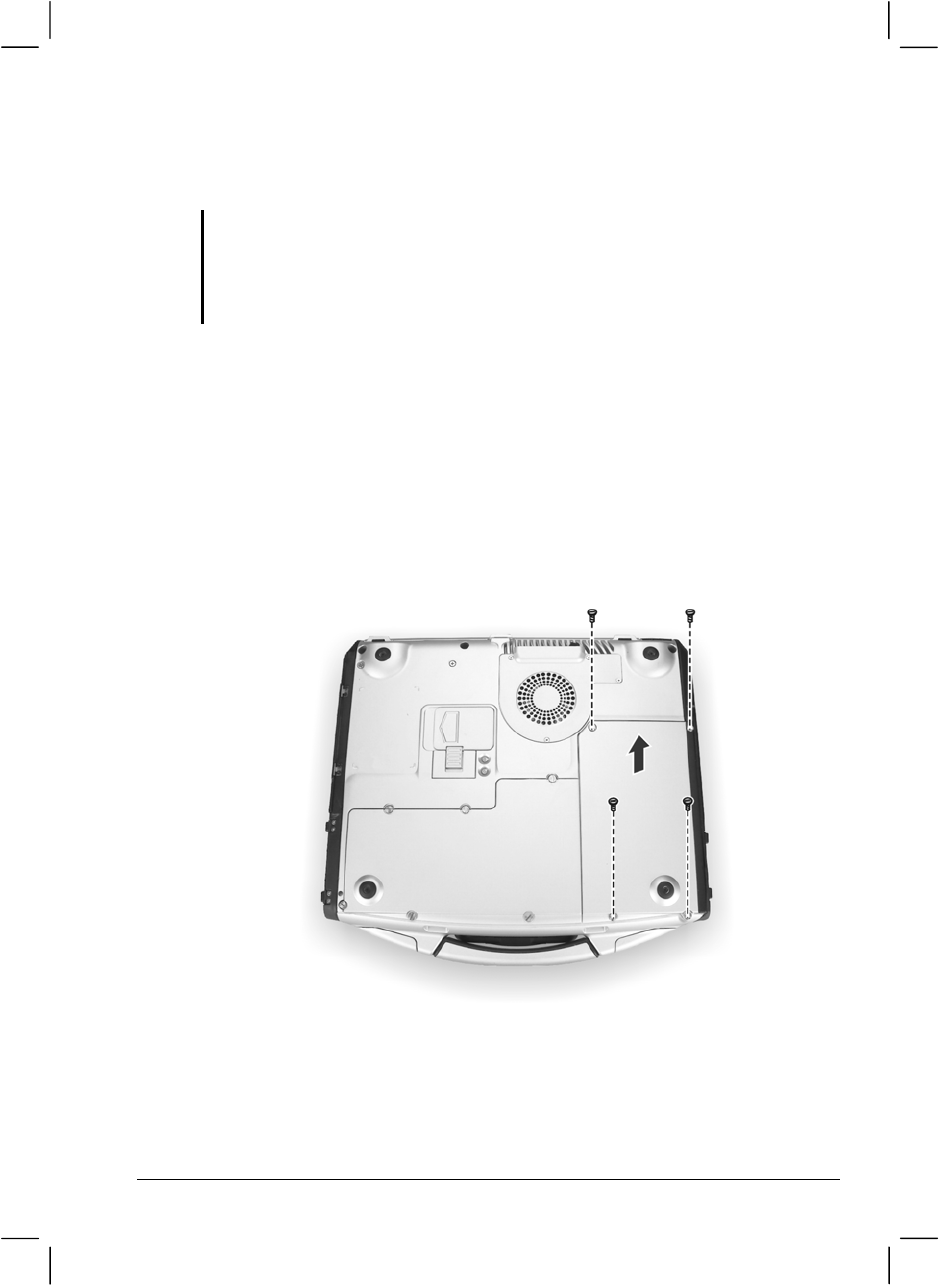
Managing Power 3-5
Replacing the Battery Pack
CAUTION:
z There is danger of explosion if the battery is incorrectly replaced. Replace the
battery only with the computer manufacturer’s optional battery packs. Discard used
batteries according to the dealer’s instructions.
z Do not attempt to disassemble the battery pack.
If you often rely on battery power for a long period of time while
traveling, you may consider the purchase of an additional battery pack
from your dealer and keep it with you in a fully charged state as a backup.
To replace the battery pack, follow these steps:
1. Make sure the computer is not turned on or connected to AC power.
2. Remove the four screws and lift the battery pack compartment cover
to take it off the computer.
3. Pull on the ribbon and take the battery pack off the computer.
4. Insert the new battery pack into the compartment.

3-6 Managing Power
5. Replace the battery pack compartment cover and secure the four
screws.
Battery Low Signals and Actions
Battery Low occurs when the battery has approximately 10% (Windows
default setting) of its charge remaining. The computer gives warning
beeps or messages and the Battery Low Indicator ( ) blinks red to
alert you to take actions.
NOTE: You can set up your threshold and signals of Battery Low under
Windows.
Immediately save your data upon Battery Low. The remaining operating
time depends on how you are using the computer. If you are using the
audio subsystem, hard or CD/DVD drives, the battery might run out of
charge very quickly.
Always respond to Battery Low by placing your computer on Standby or
Hibernation mode, turning off the computer, or connecting the AC
adapter.
If you do not take any action, the computer will automatically hibernate
and turn off.
CAUTION: If you fail to save your data when the battery completely runs out of charge,
then you lose your data.

Managing Power 3-7
Power Management
Your computer supports ACPI (Advanced Configuration and Power
Interface) for power management. The power management feature allows
you to reduce the power consumption for energy saving.
With an ACPI-compliant operating system such as Windows 2000 and
Windows XP, power supply to different computer components is
controlled on an as-needed basis. This allows maximum power
conservation and performance at the same time.
In general, Windows’ power management works in this way:
What …When …
Power to the hard disk is turned off When the hard disk has been idle for a
set period.
Power to the display is turned off When the display has been idle for a set
period.
When the entire system has been idle
for a set period.
When you press Fn+F10. *
When you close the cover. *
The computer enters Standby mode.
The hard disk and display are turned
off and the entire system consumes
less power.
When you press the power button. *
When you press the power button. *
When you press Fn+F10. *
The computer enters Hibernation
mode. (See the next subsection for
more information.) When you close the cover. *
* depends on your settings in Windows.
For detailed information on power management, see Windows’ Help.

3-8 Managing Power
Hibernation
Hibernation is a very useful feature. People frequently open many
applications when they use computers. It takes some time to get all these
applications open and running, and normally they all have to be closed
before the system can be turned off.
When you use the hibernation feature, you do not have to close the
applications. The computer stores the state of your computer to a file on
the hard disk and then shut down. The next time you turn on your
computer, you return to exactly where you left off.

Managing Power 3-9
Power-Saving Tips
In addition to your computer’s automatic power management, you can do
your part to maximize the battery’s operating time by following these
suggestions.
l Do not disable Power Management.
l Decrease the LCD brightness to the lowest comfortable level.
l Disable the parallel and serial ports if no devices are connected to
these ports. (See “Components Menu” in Chapter 5.)
l If you work with an application that uses the serial port or features
wireless connectivity (LAN/modem/GPS), exit the application when
you finish using it.
l Turn off the computer when you are not using it.